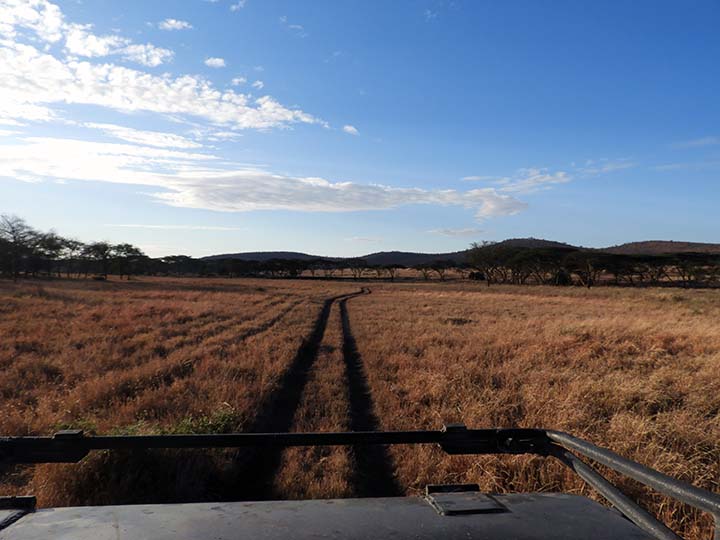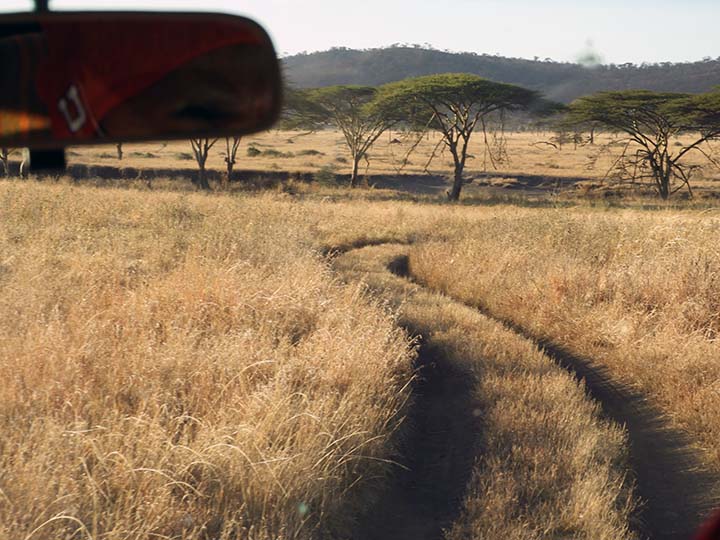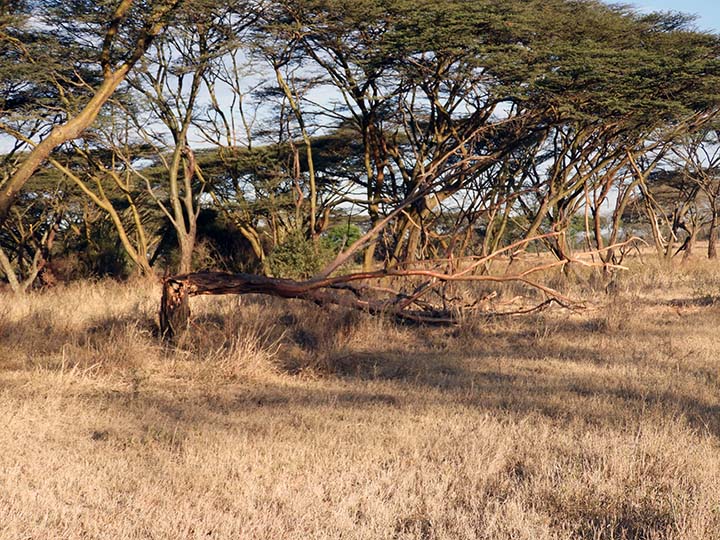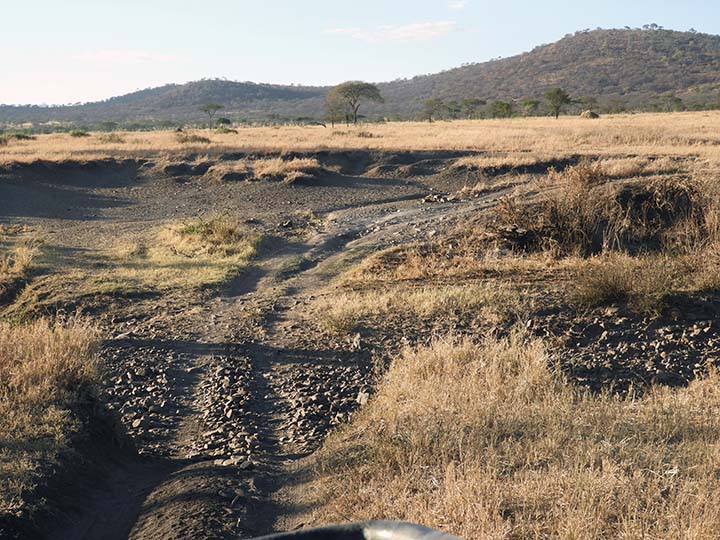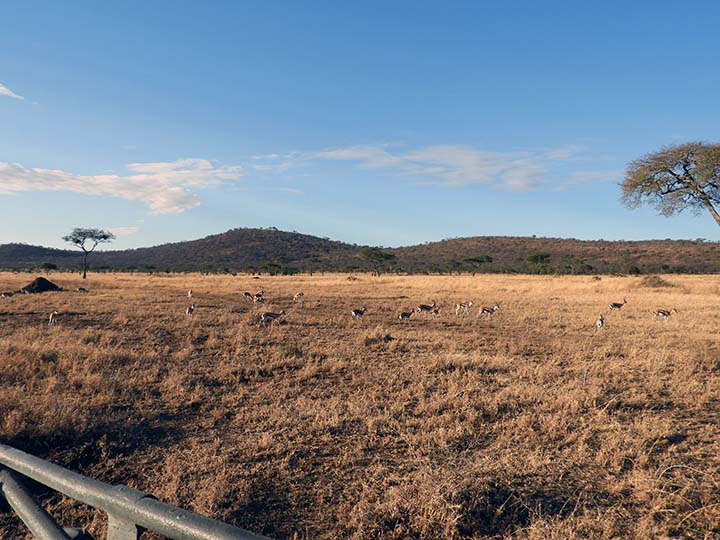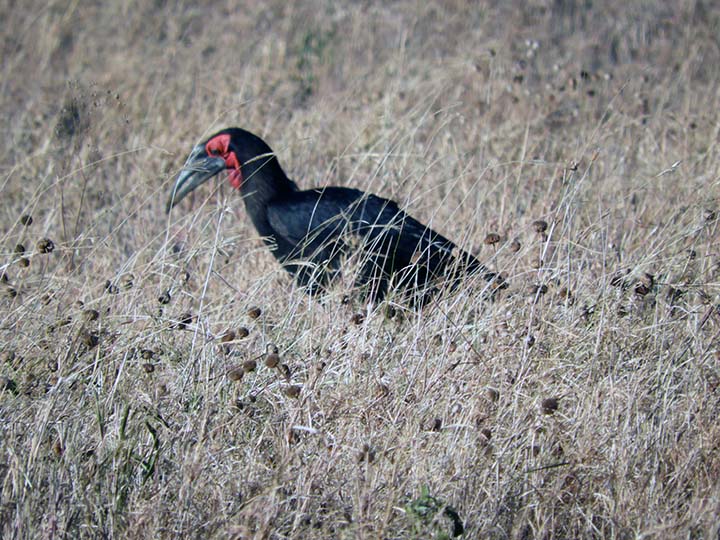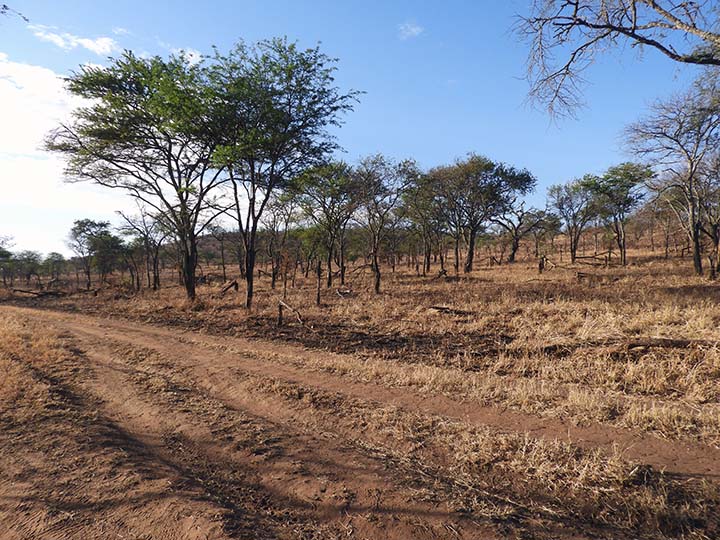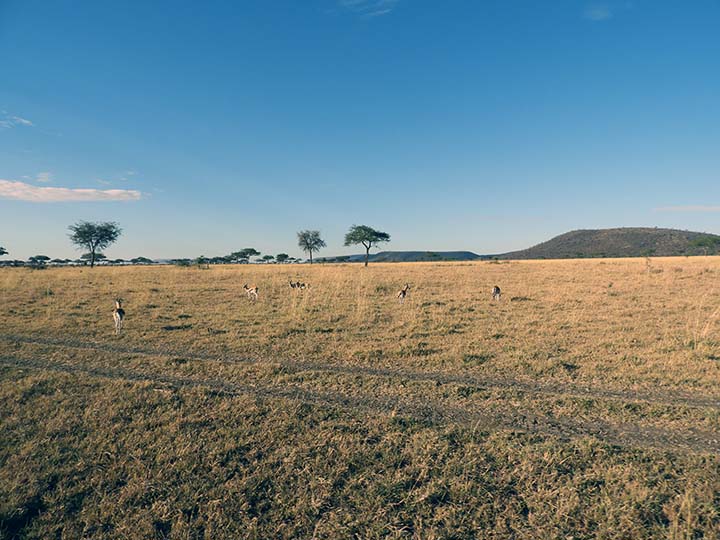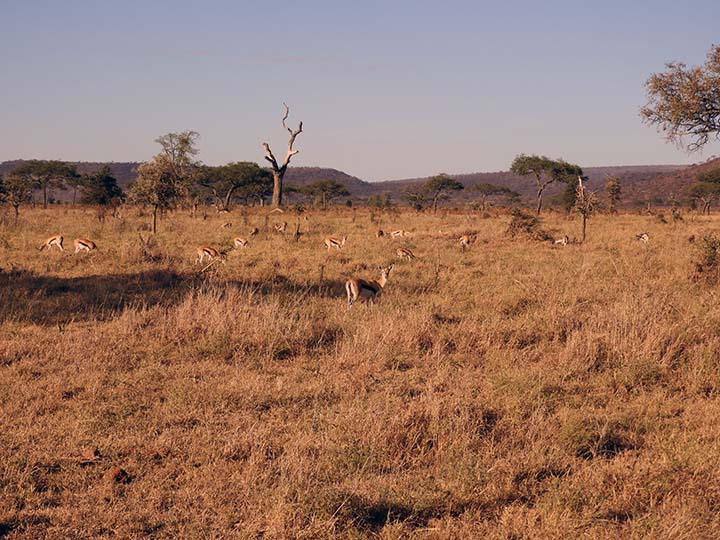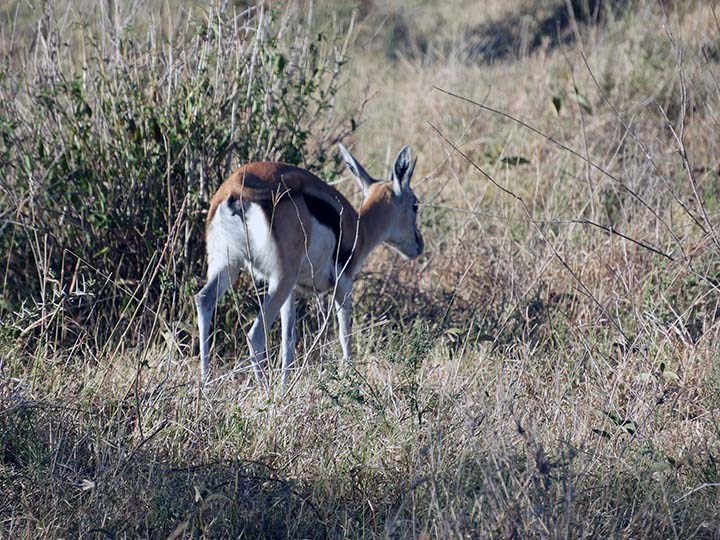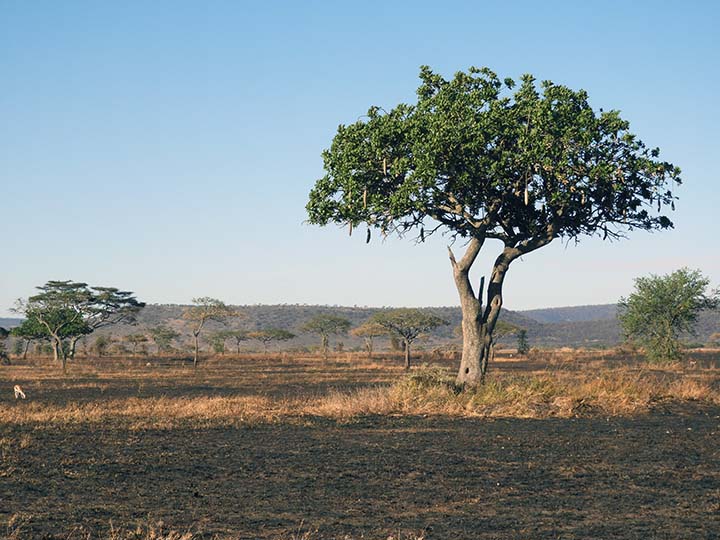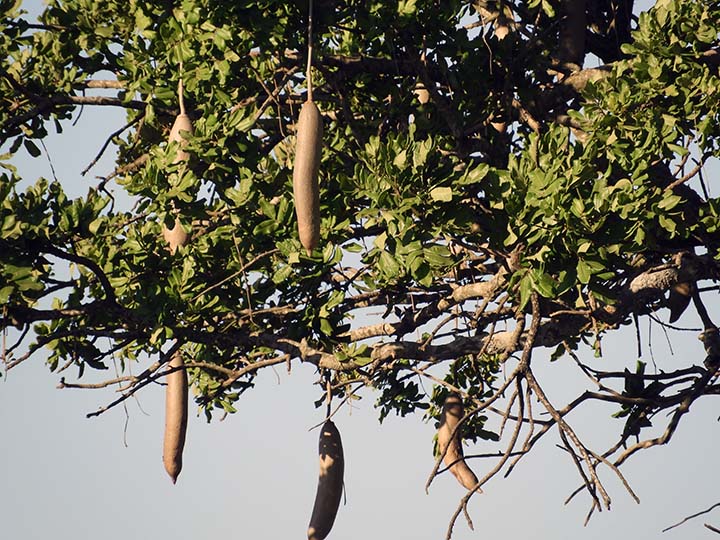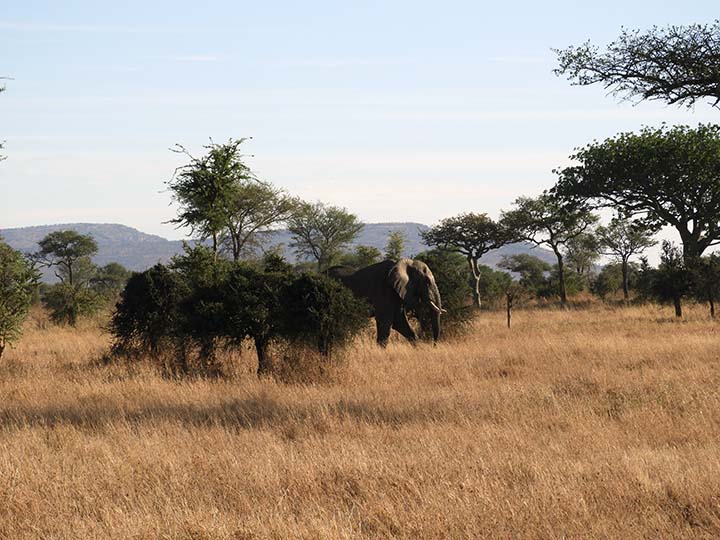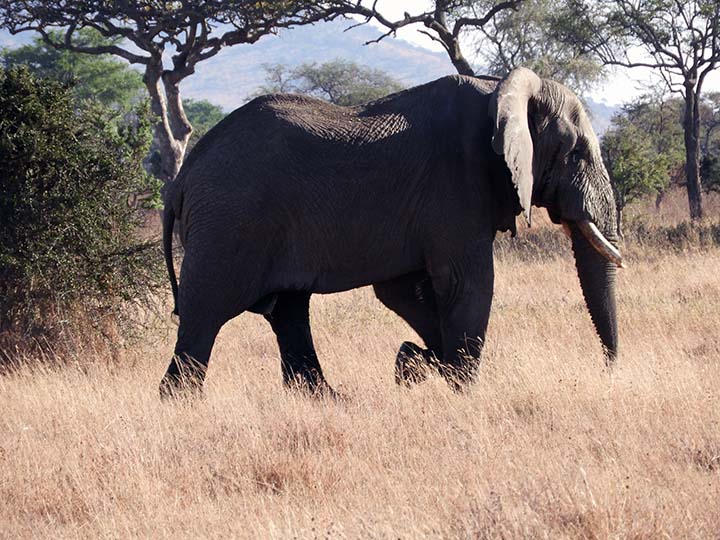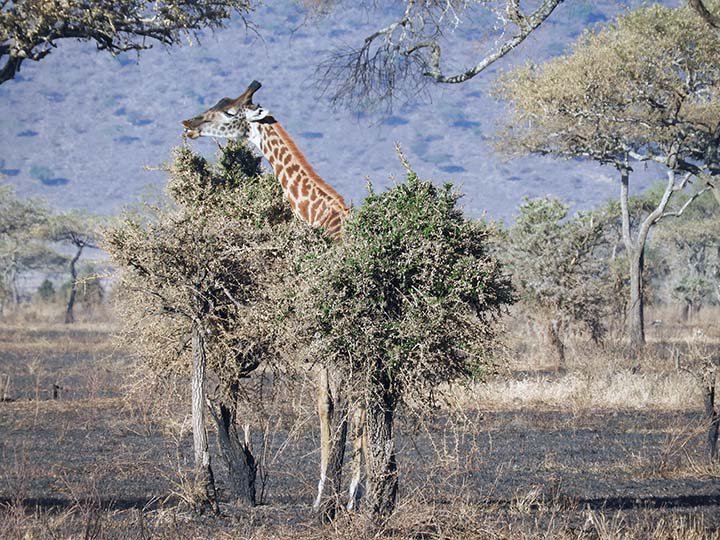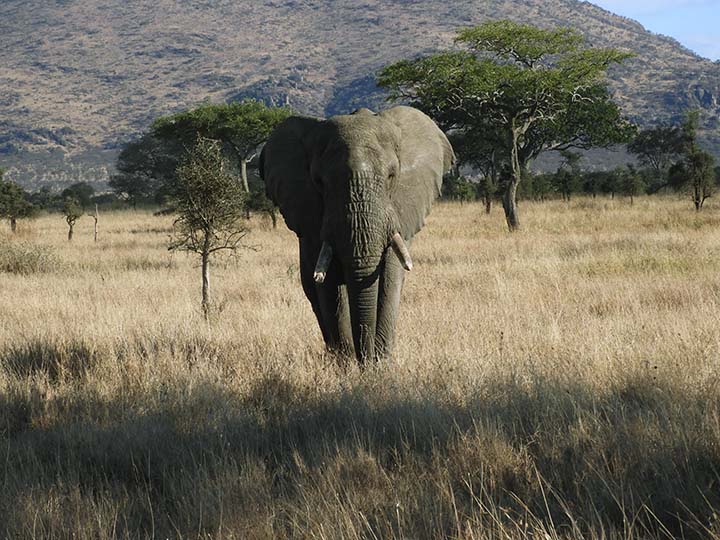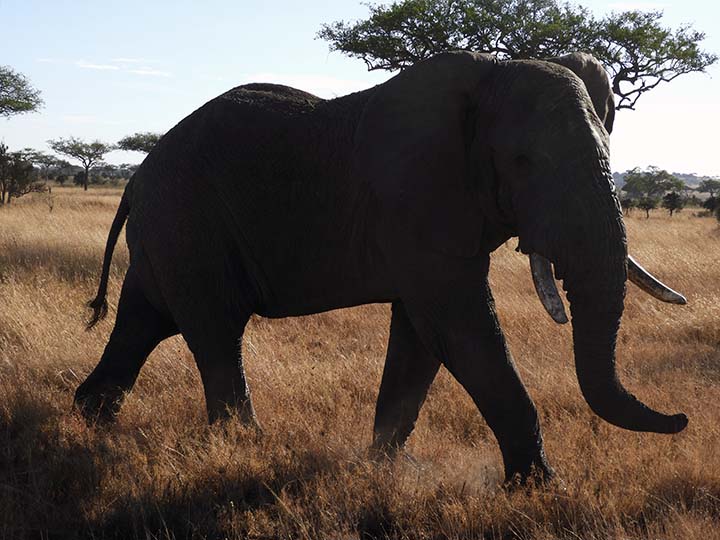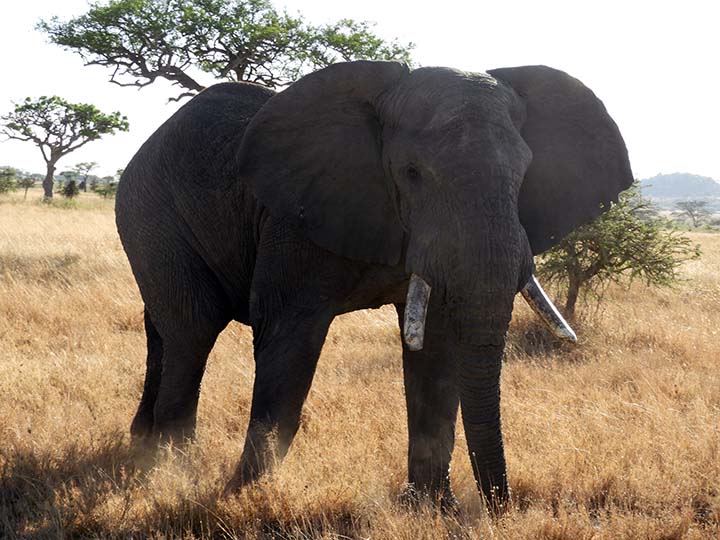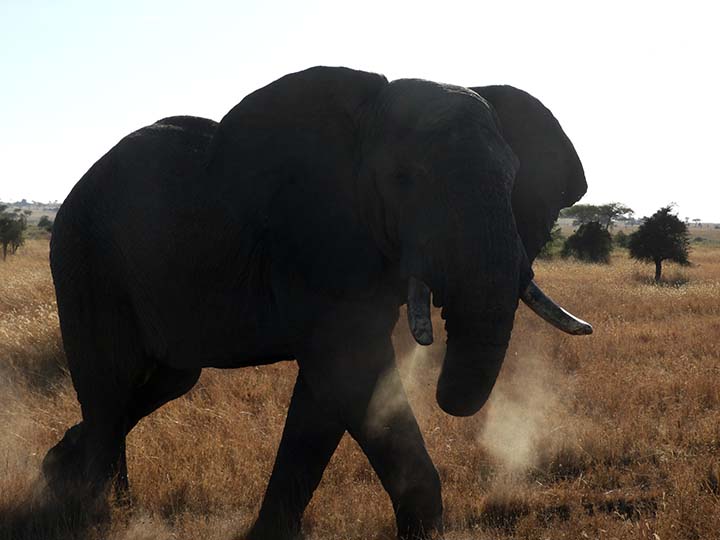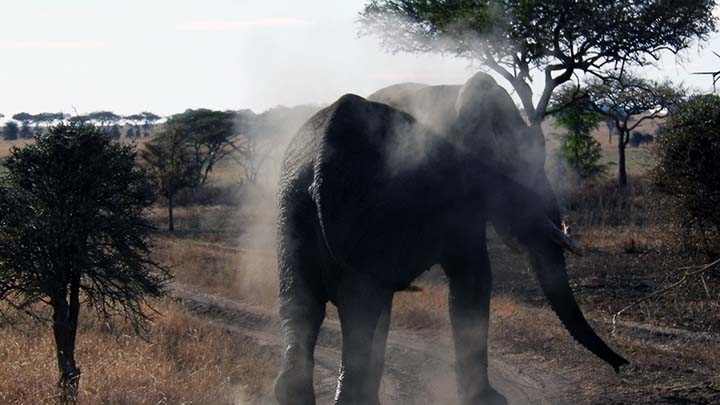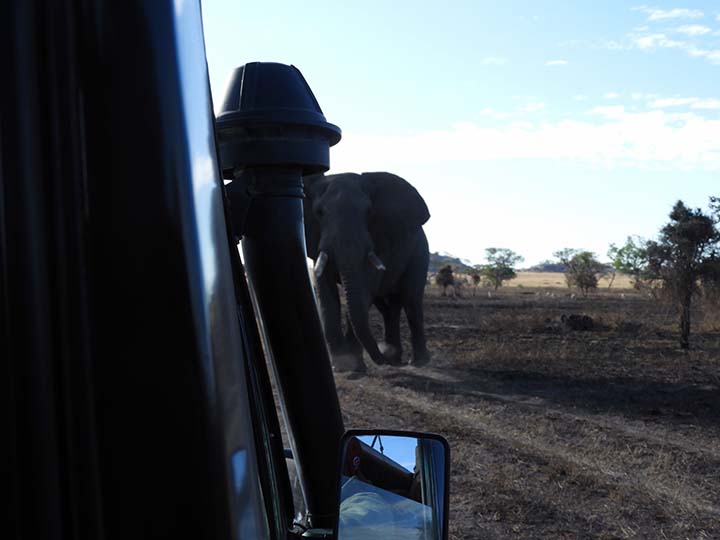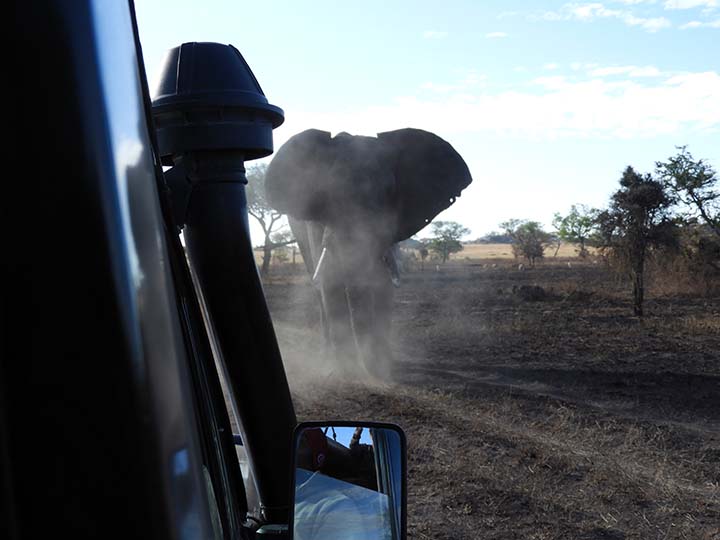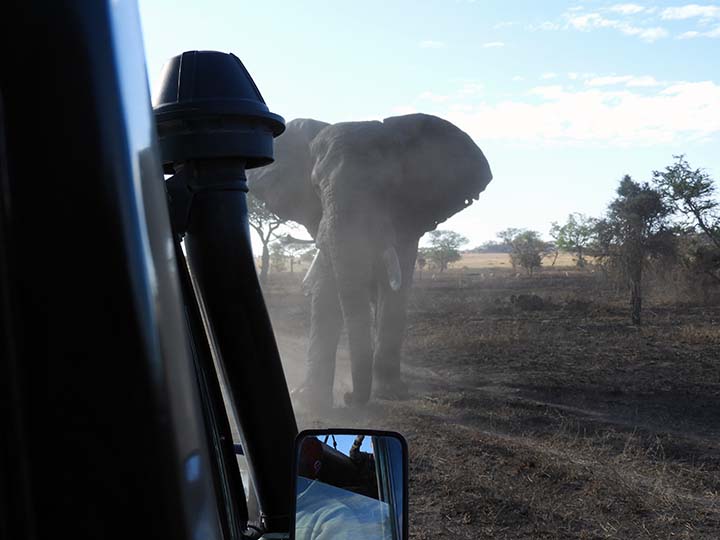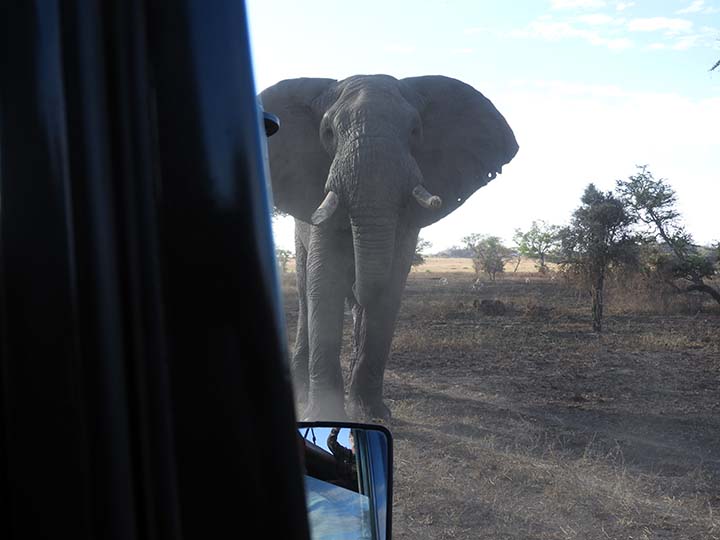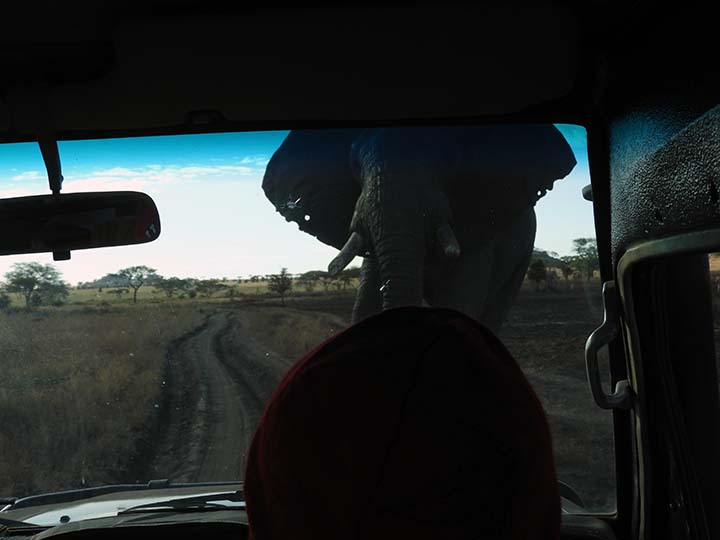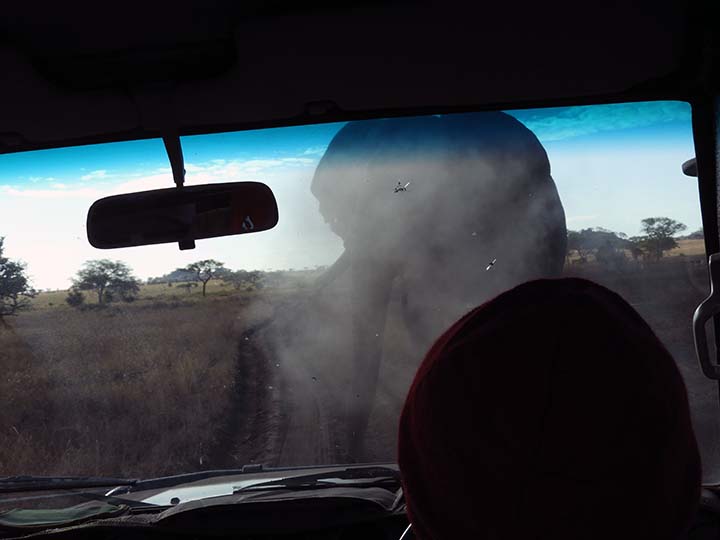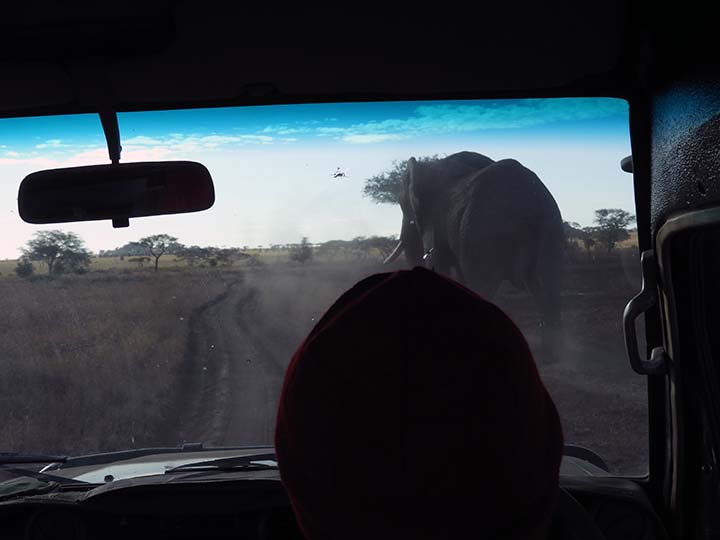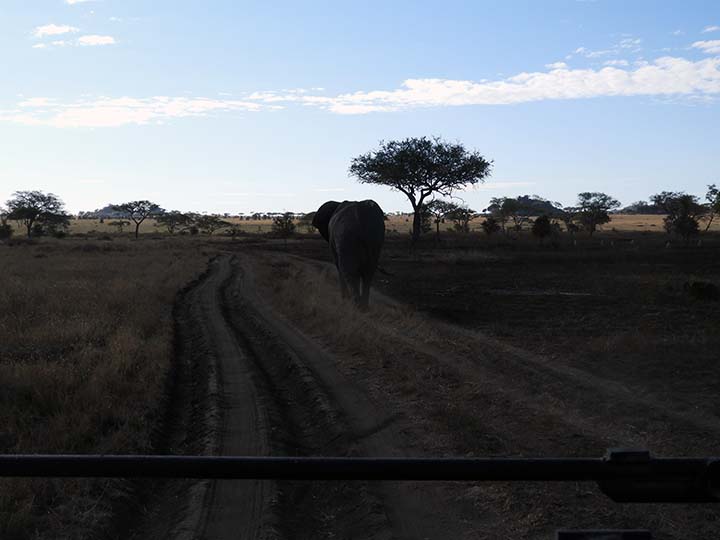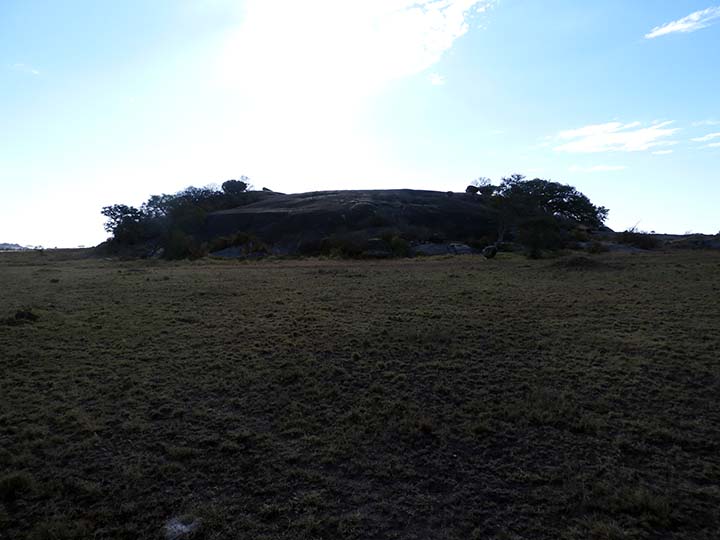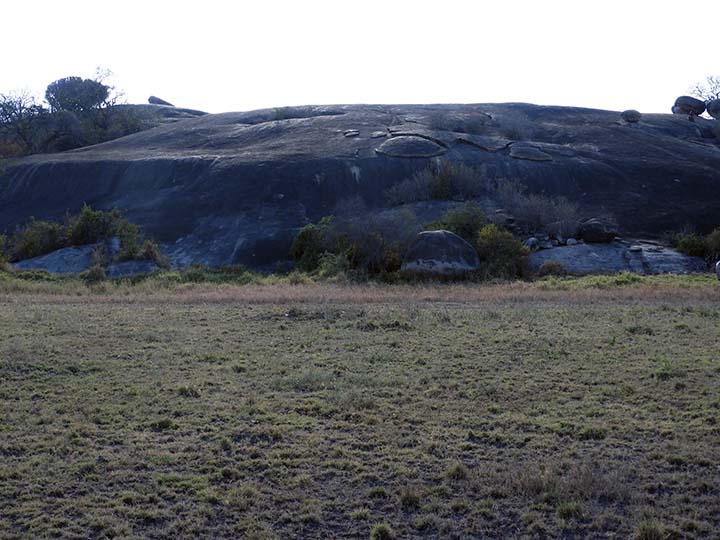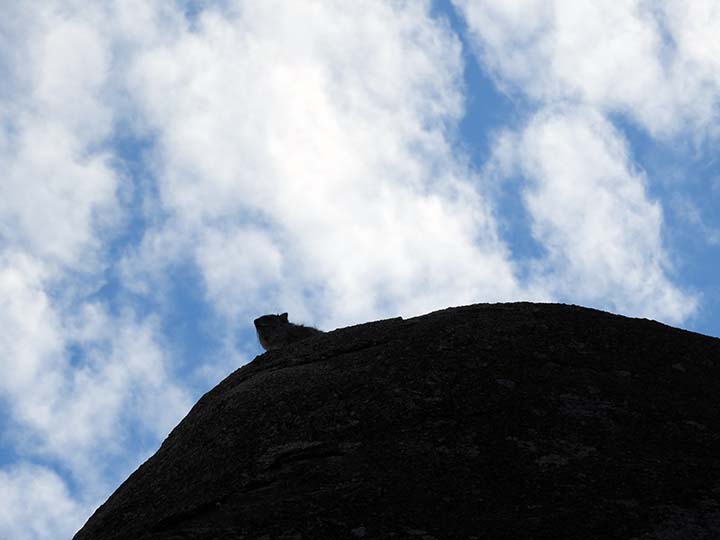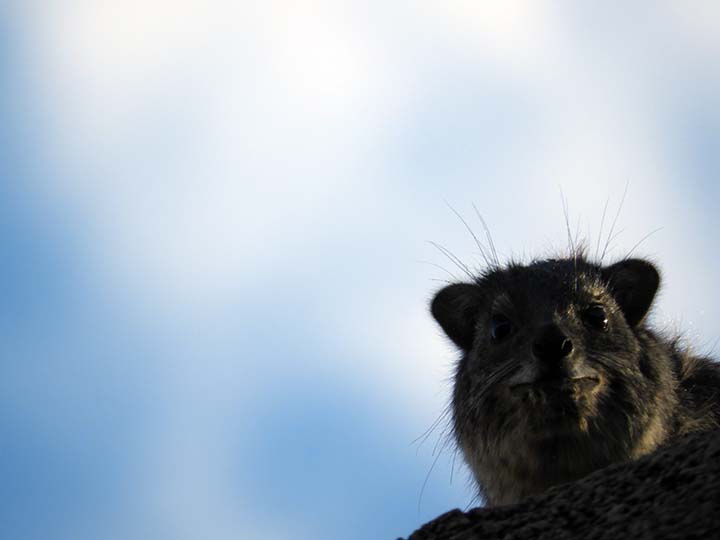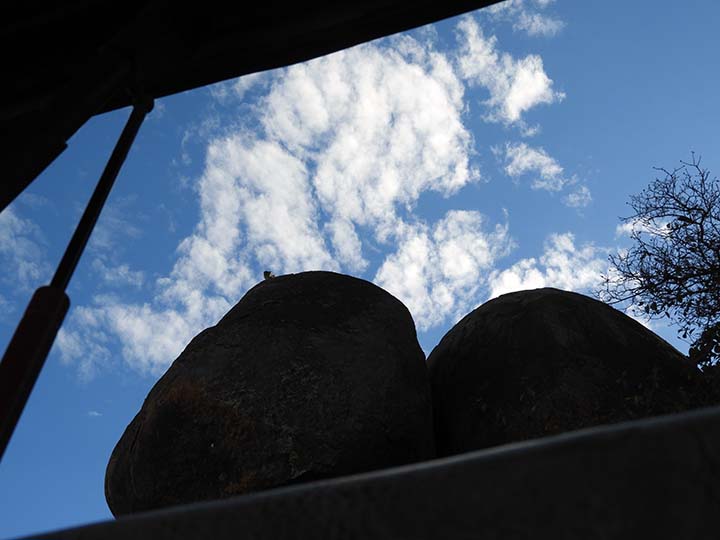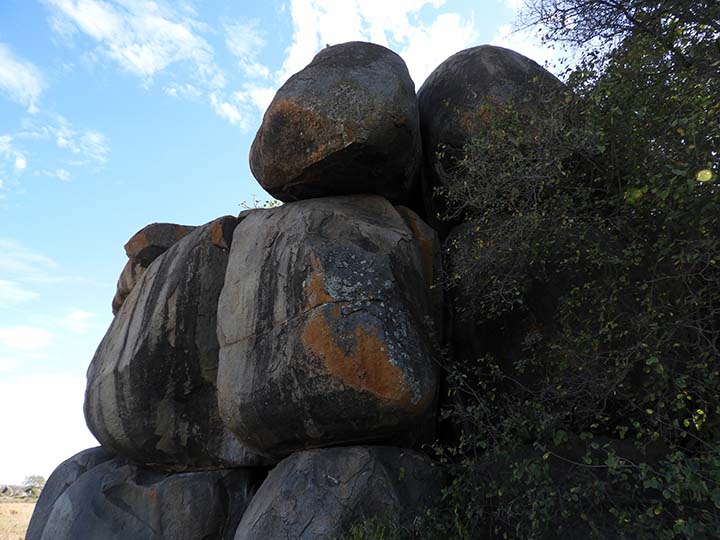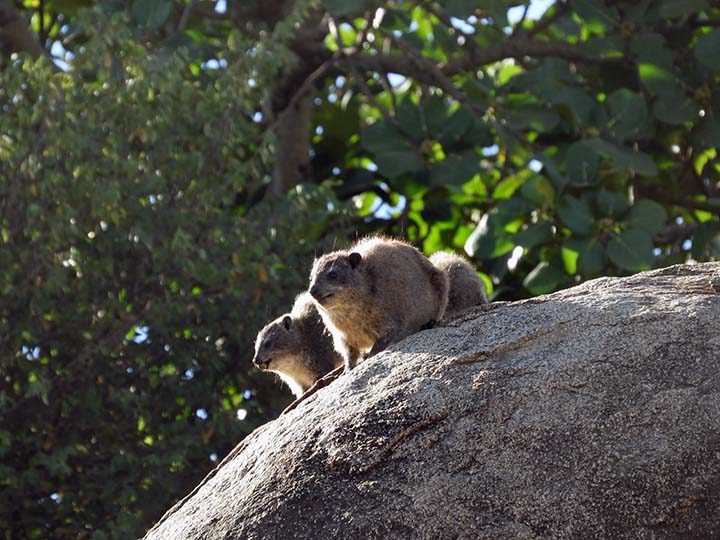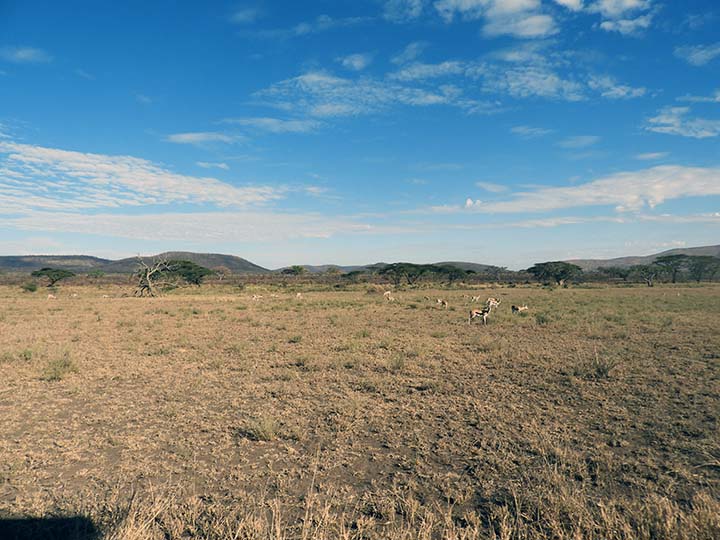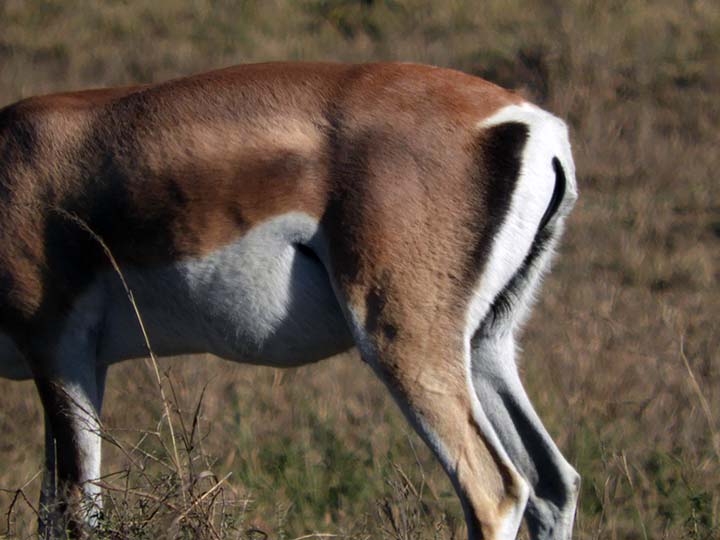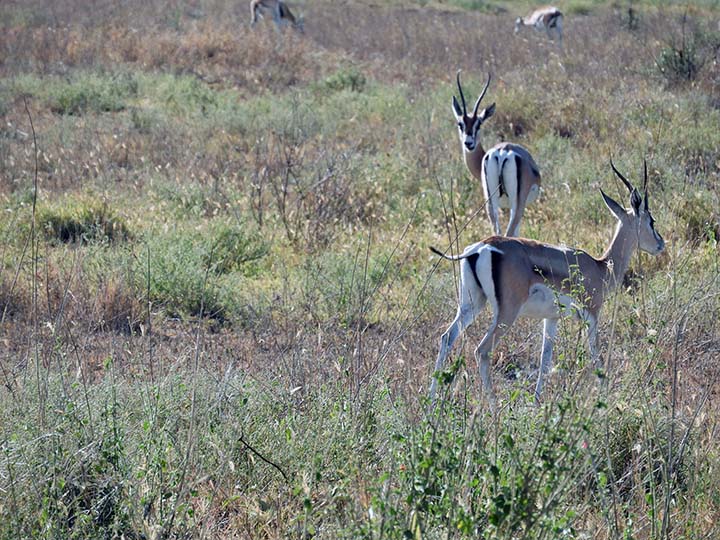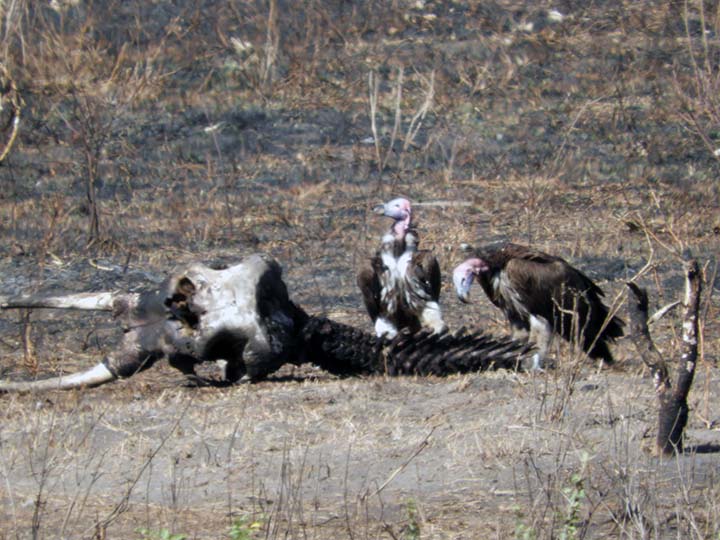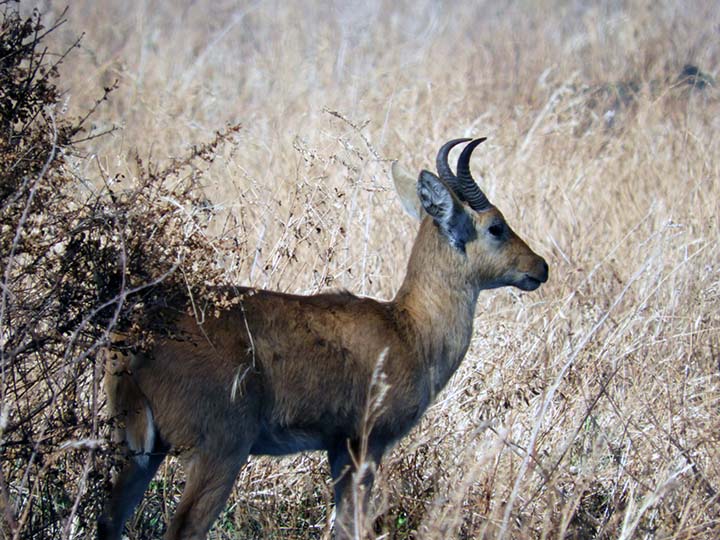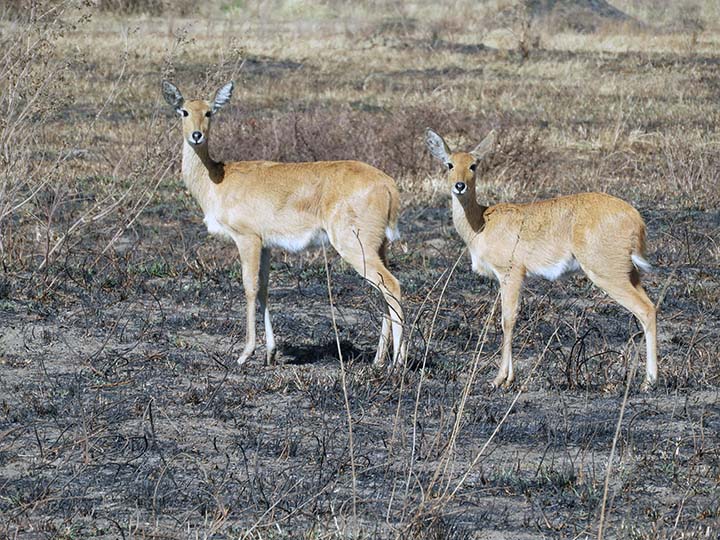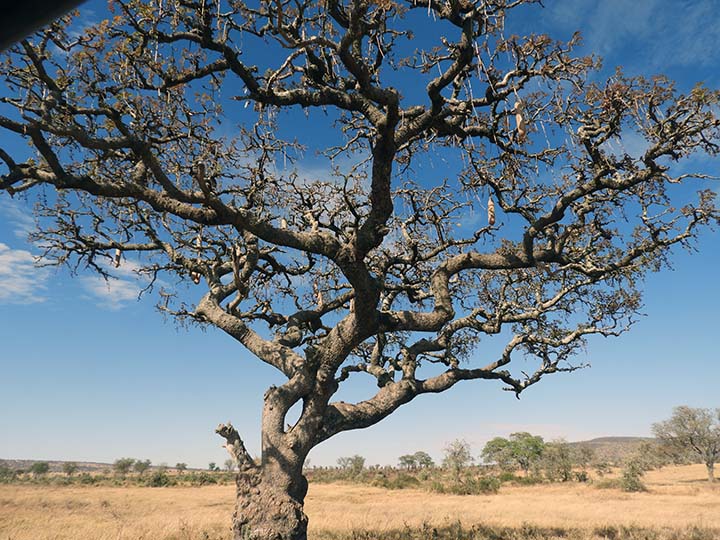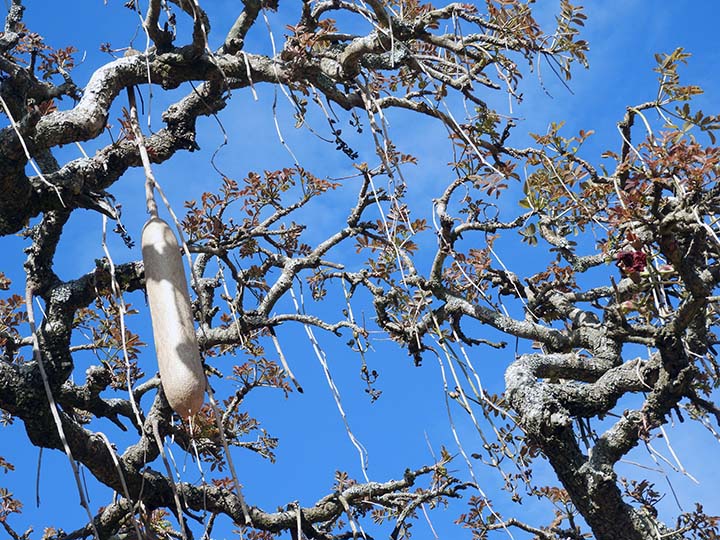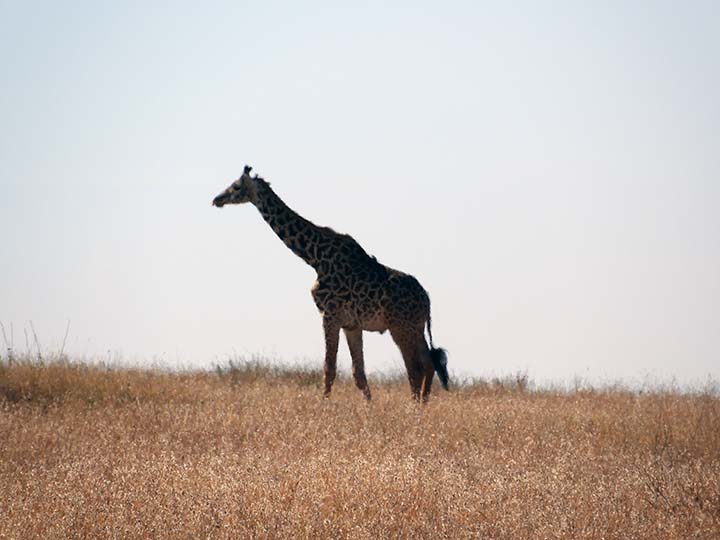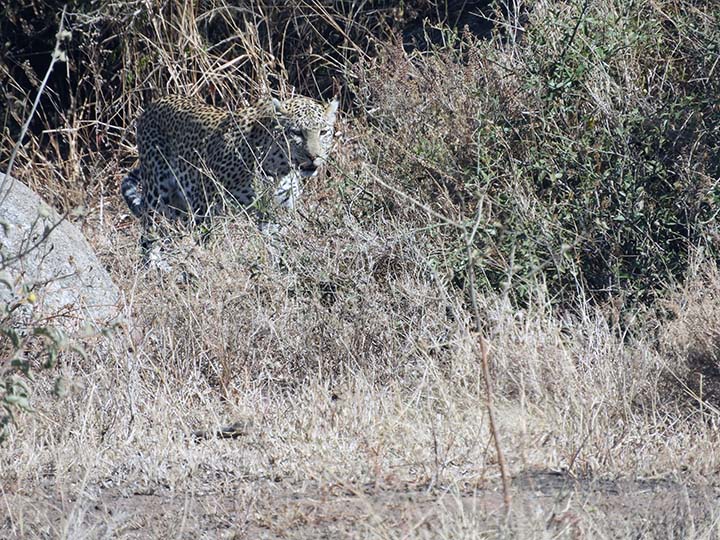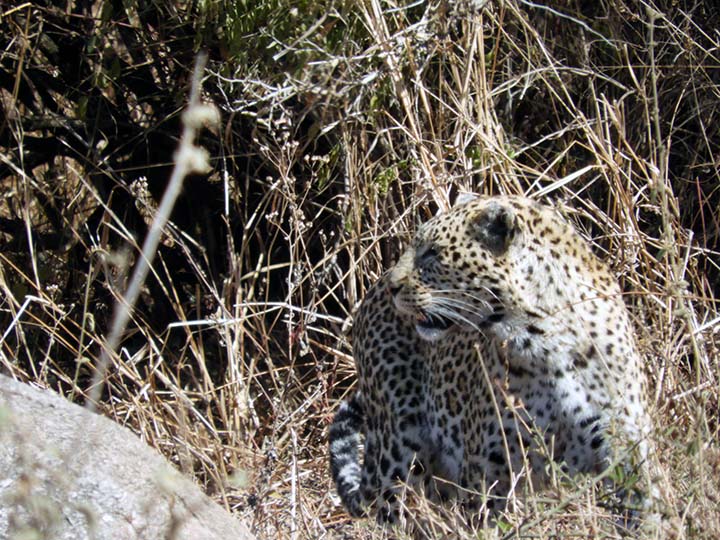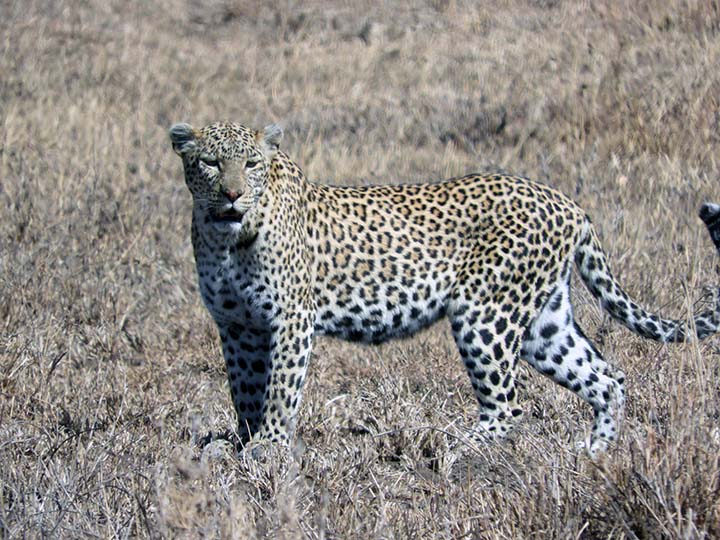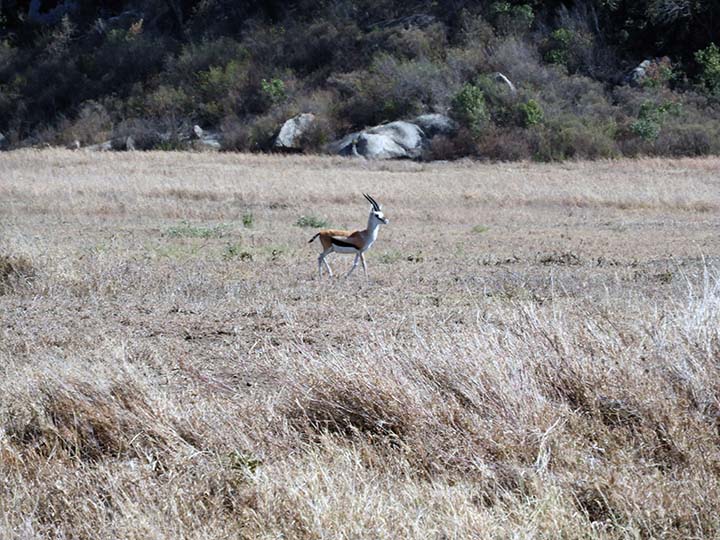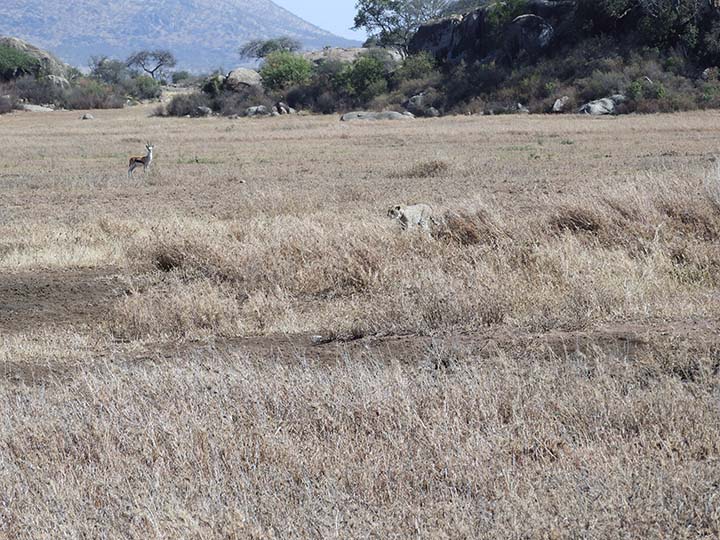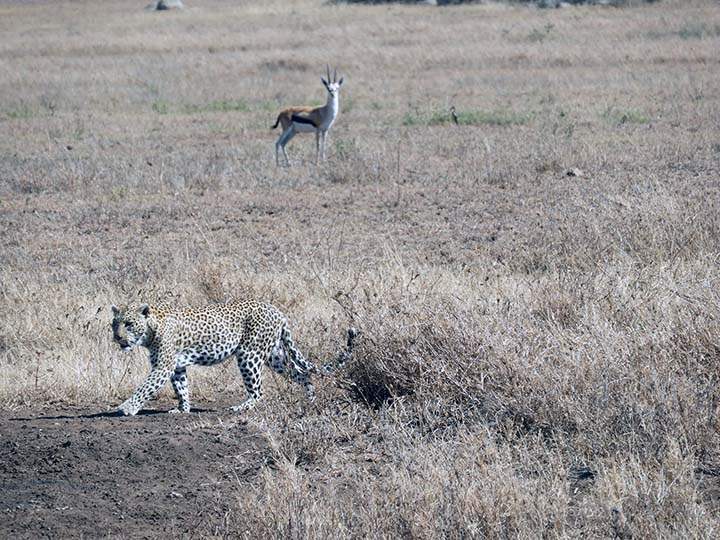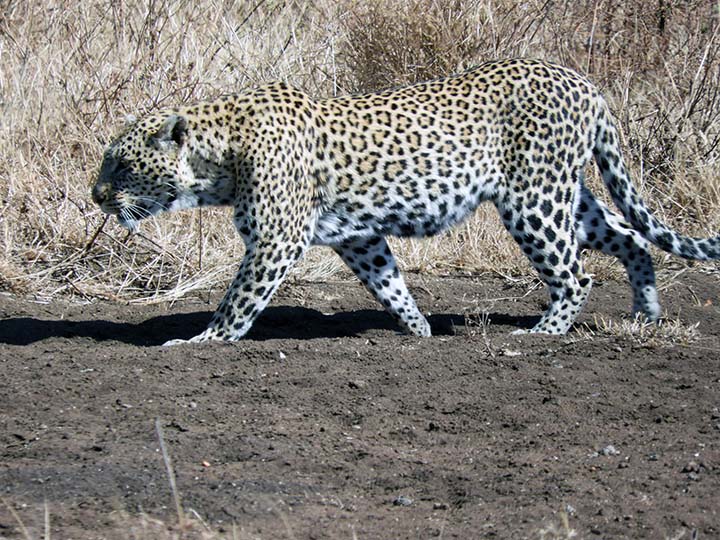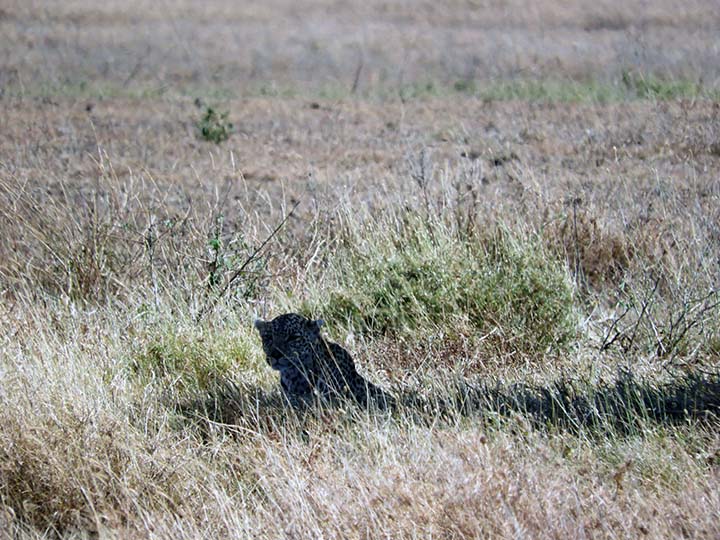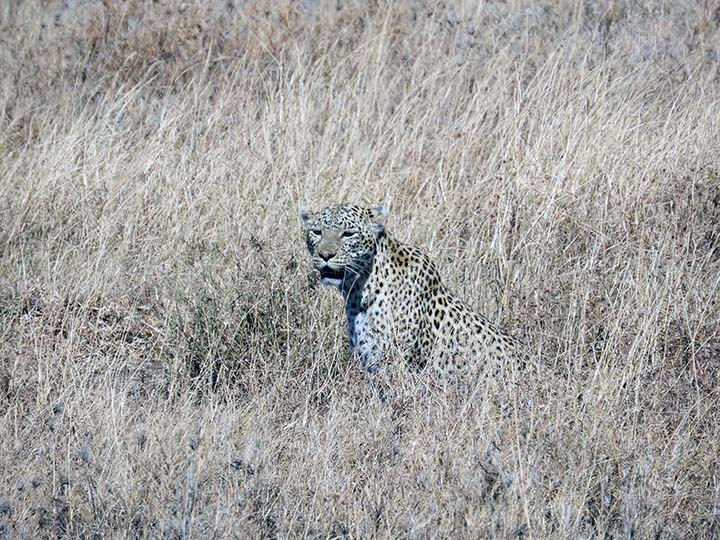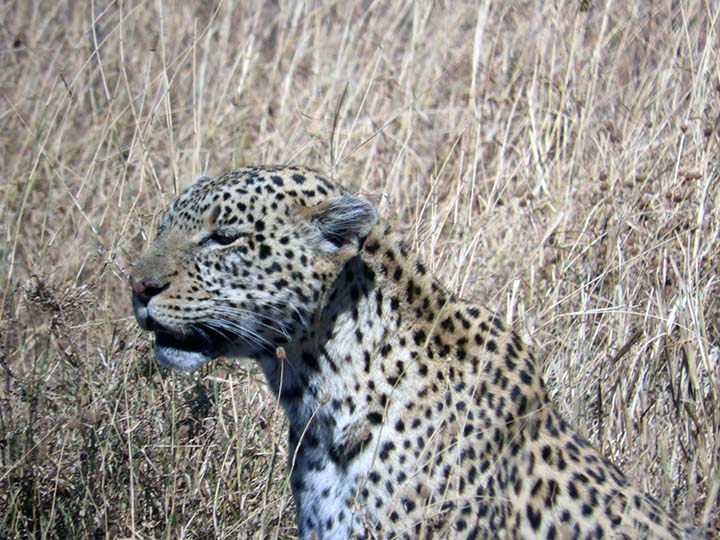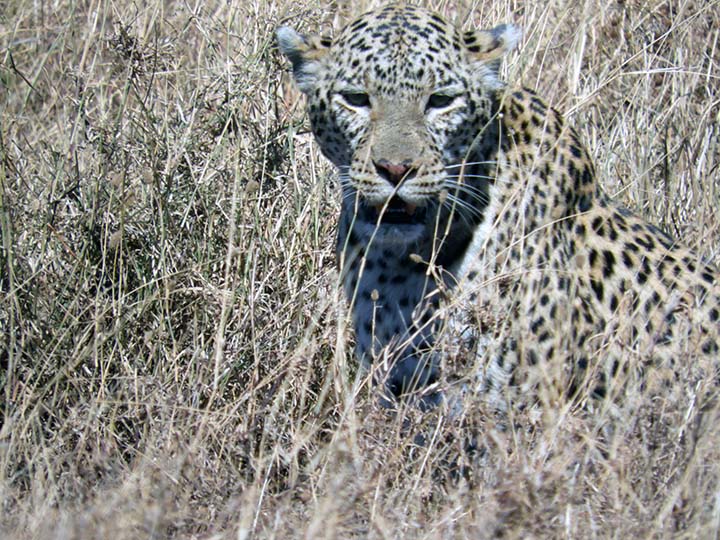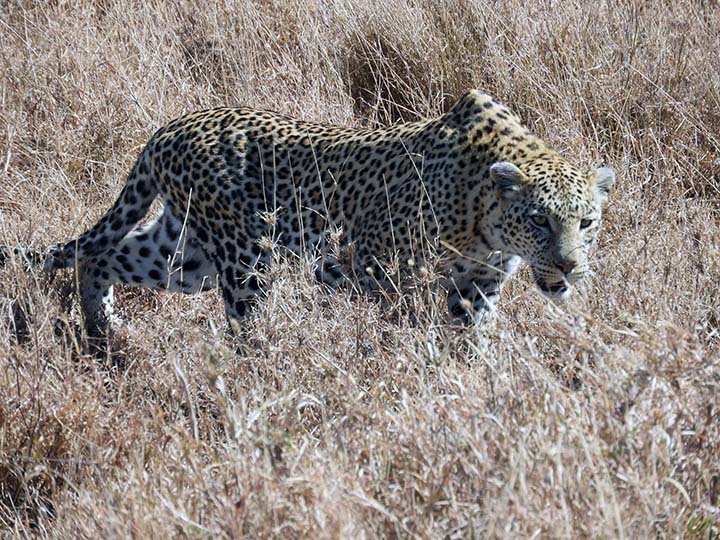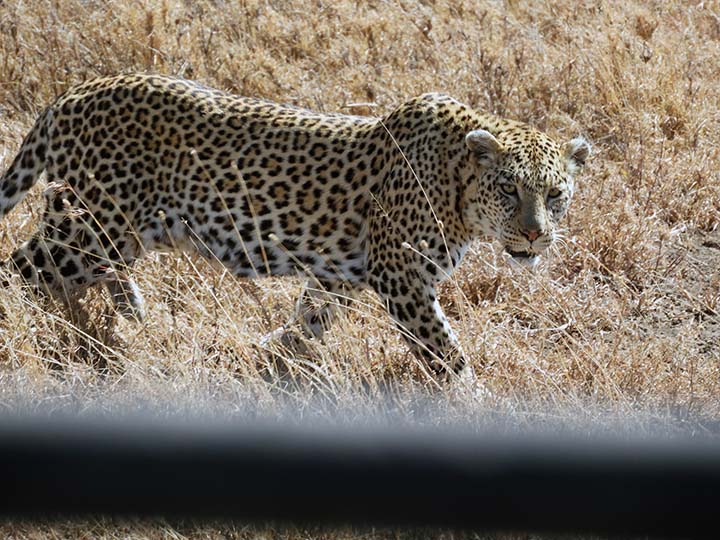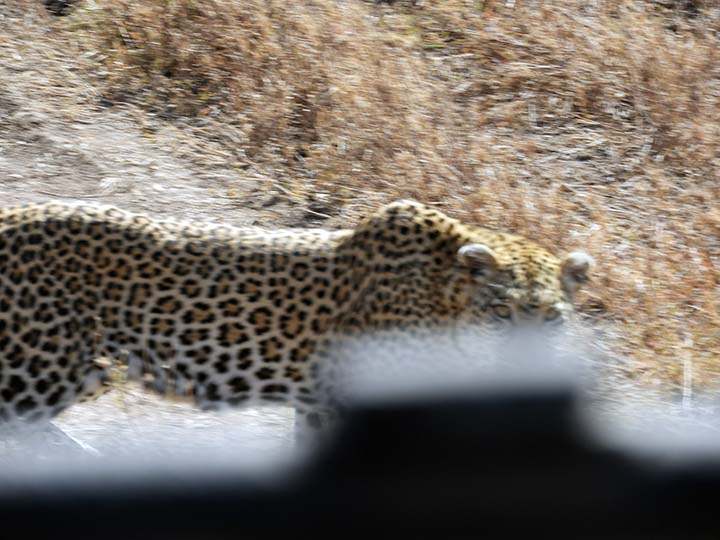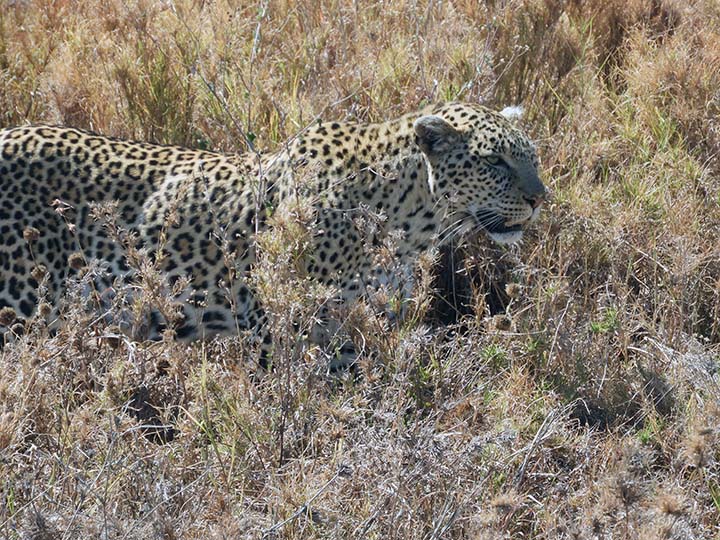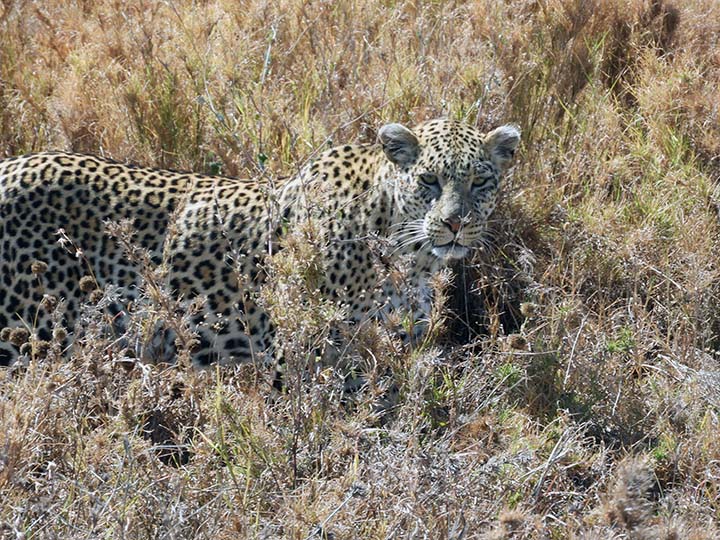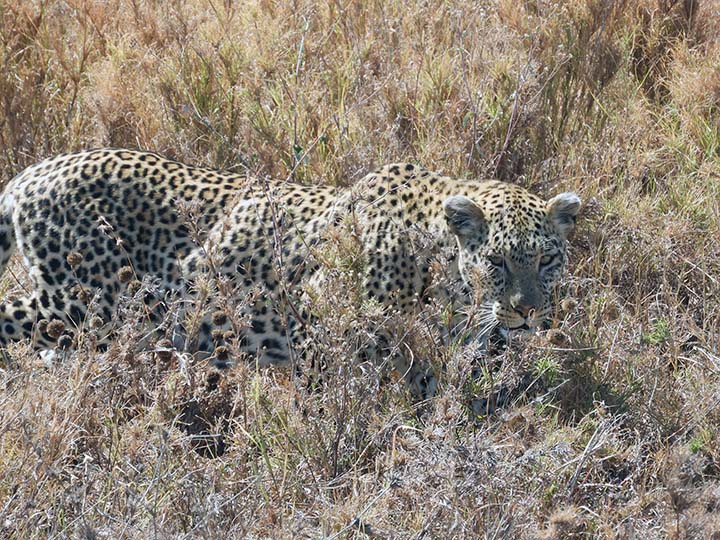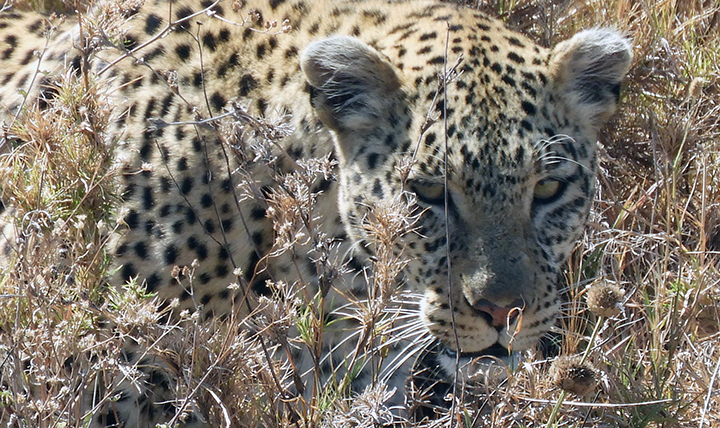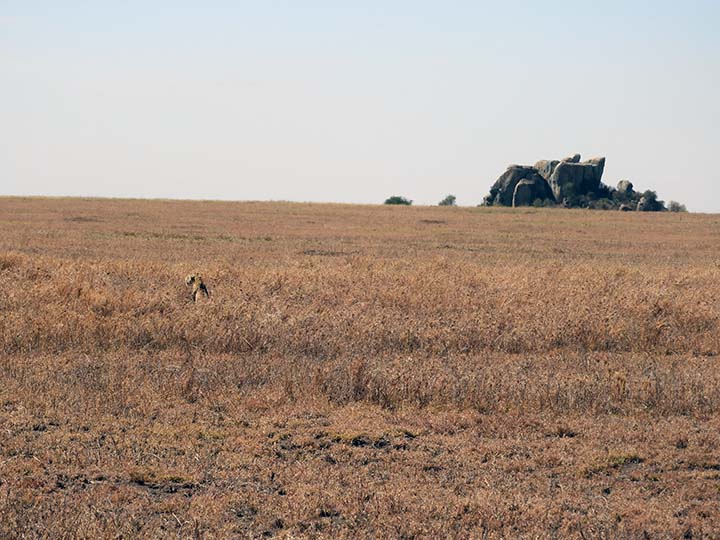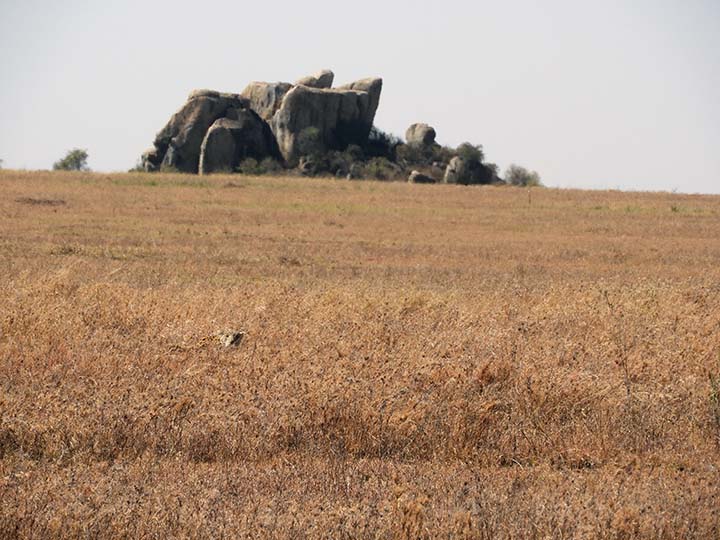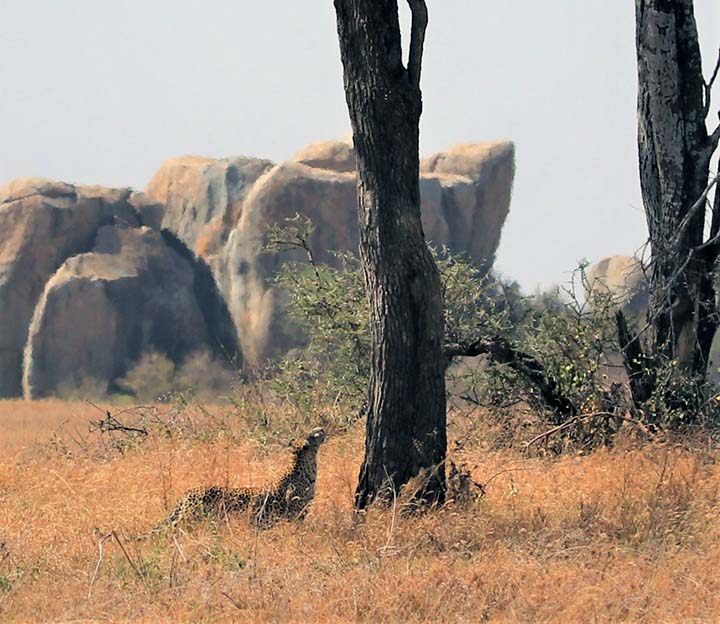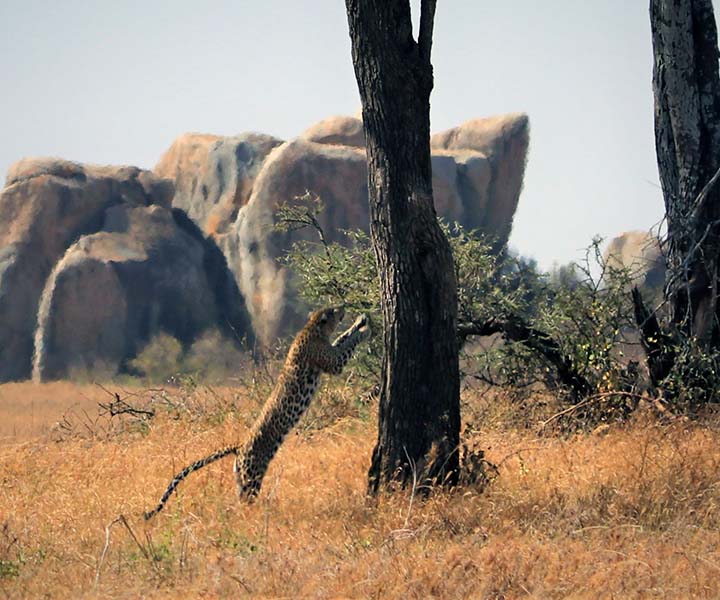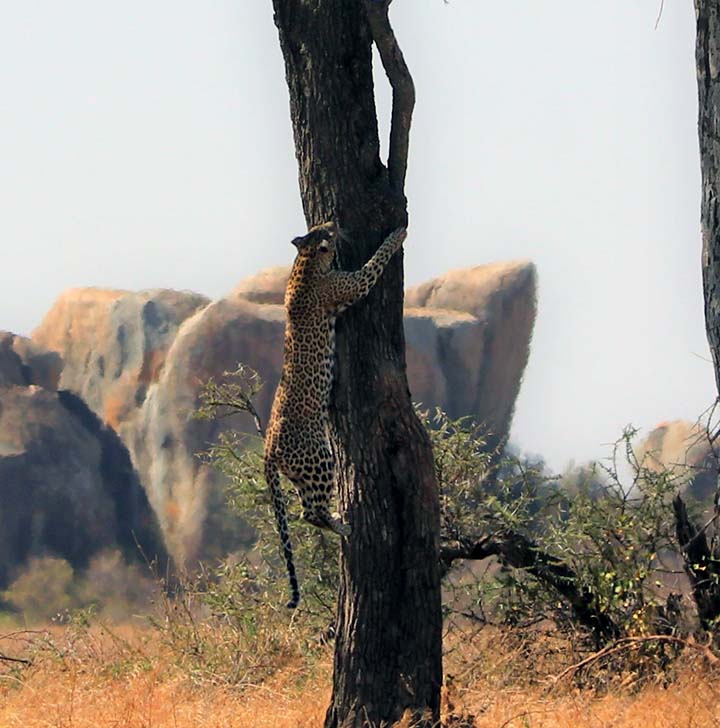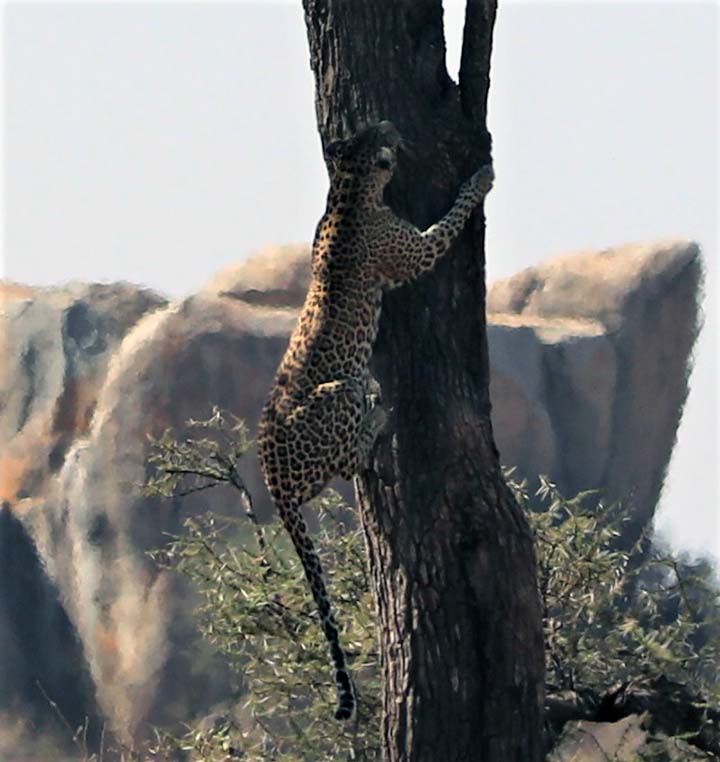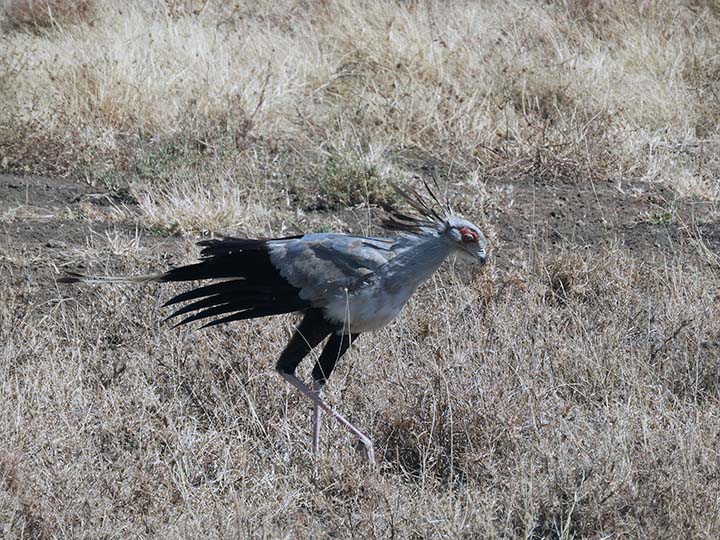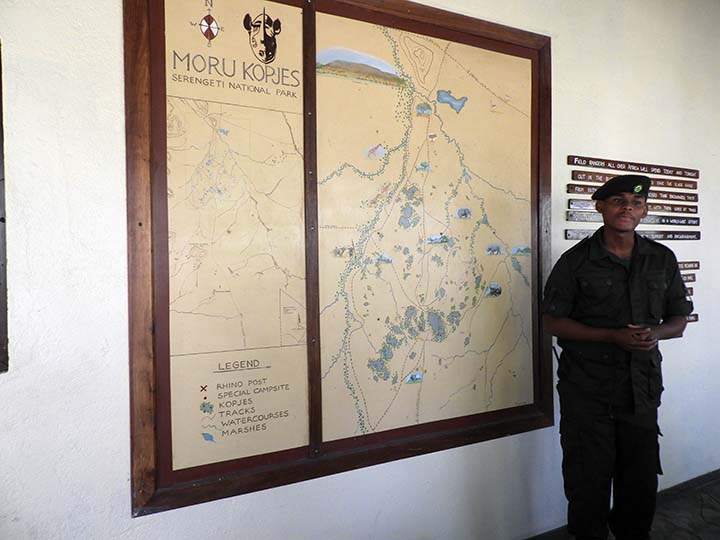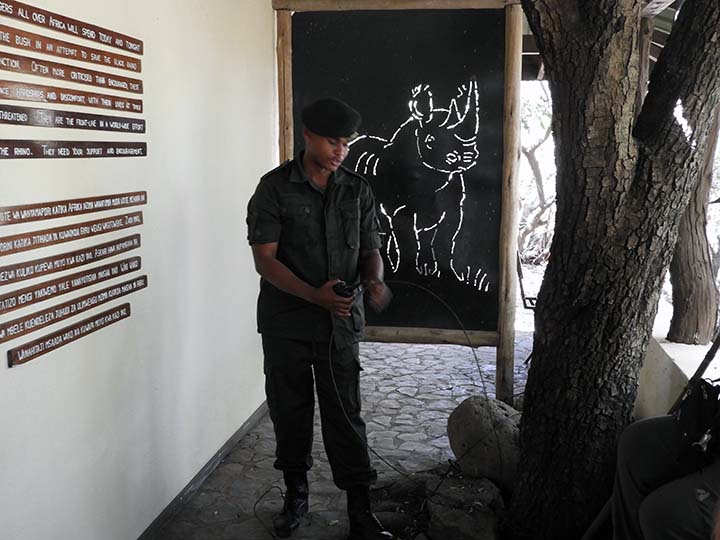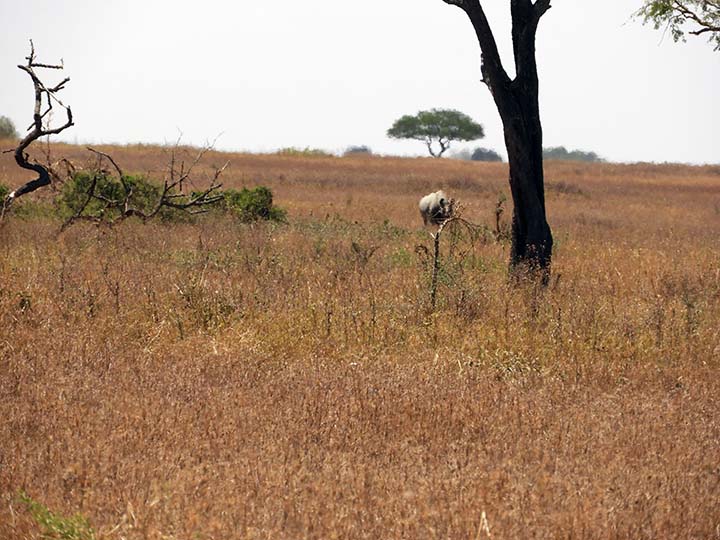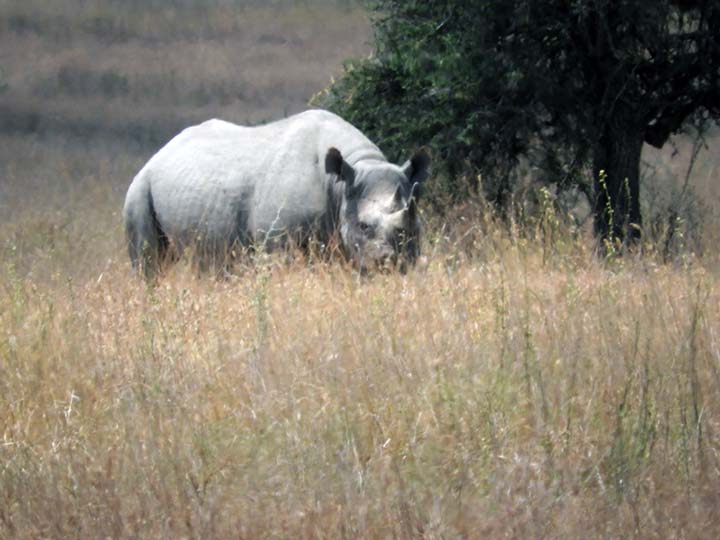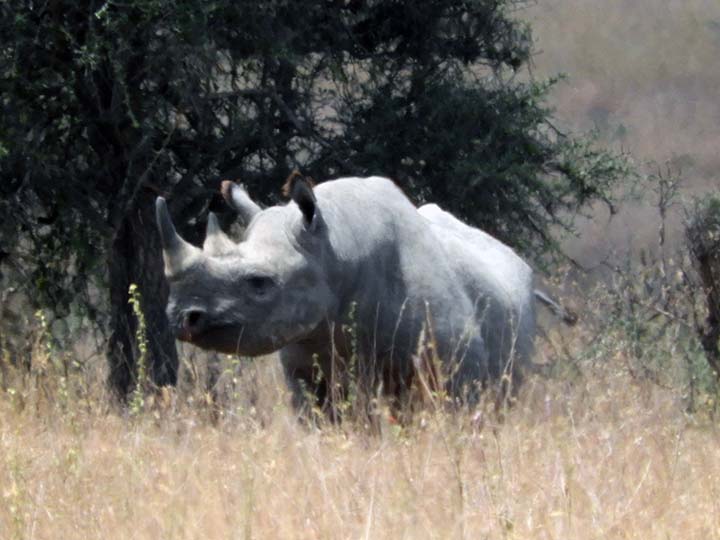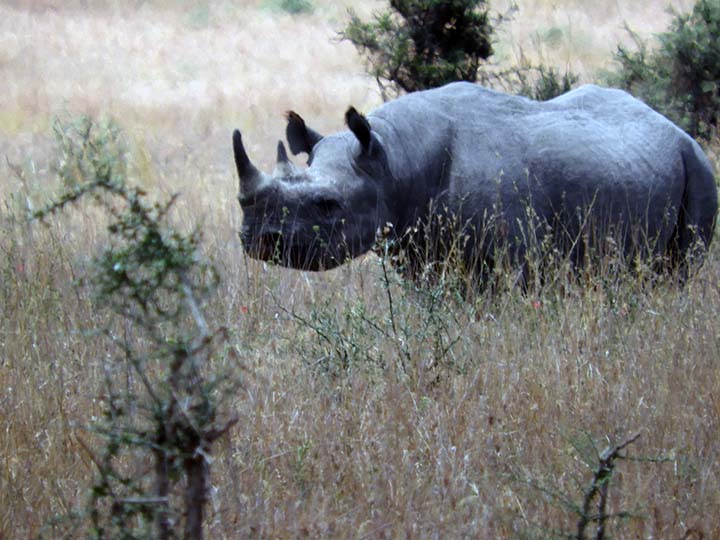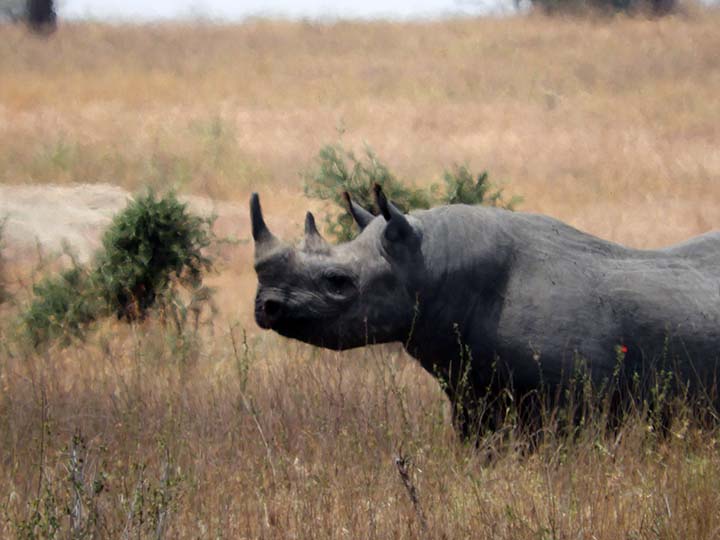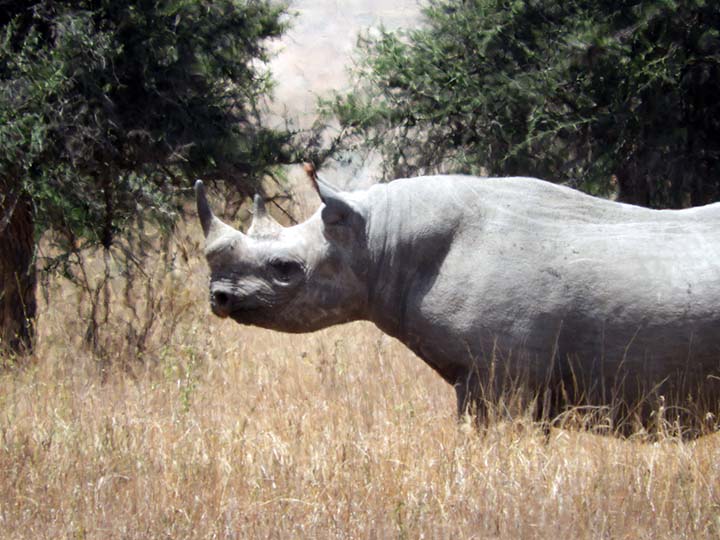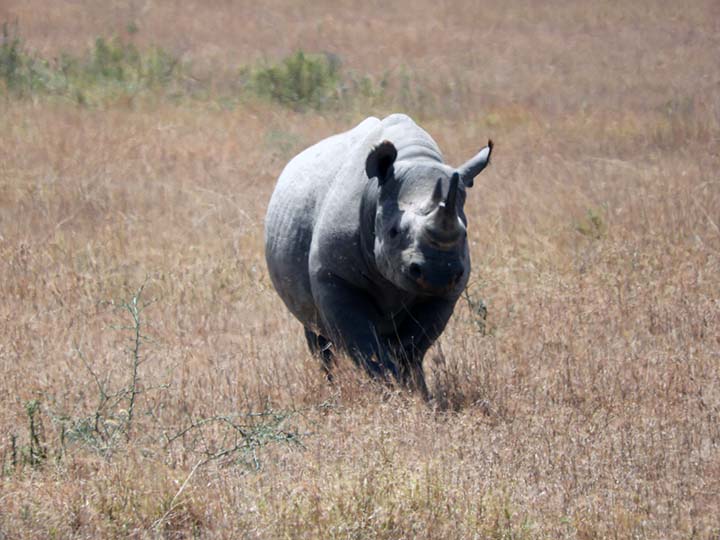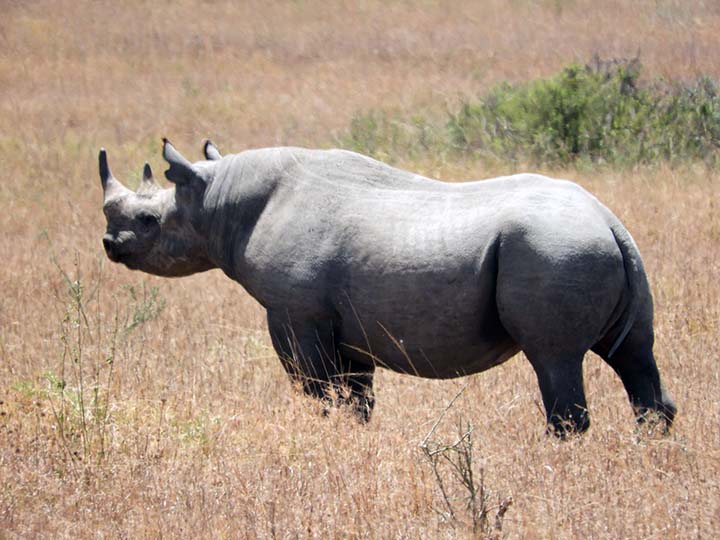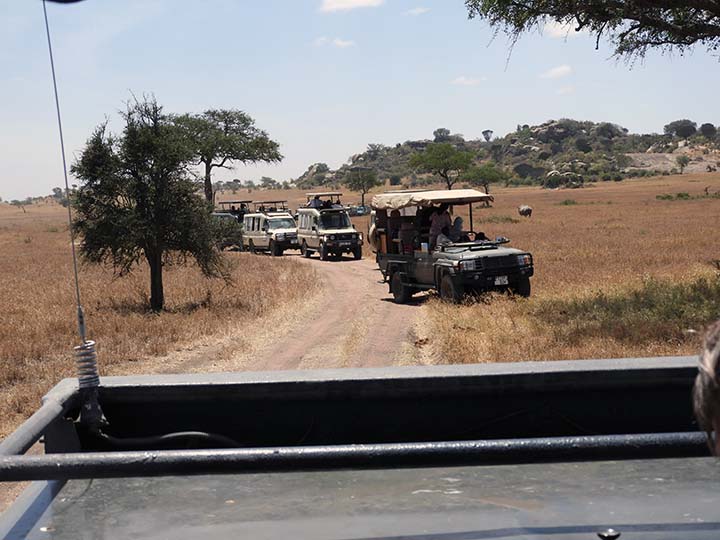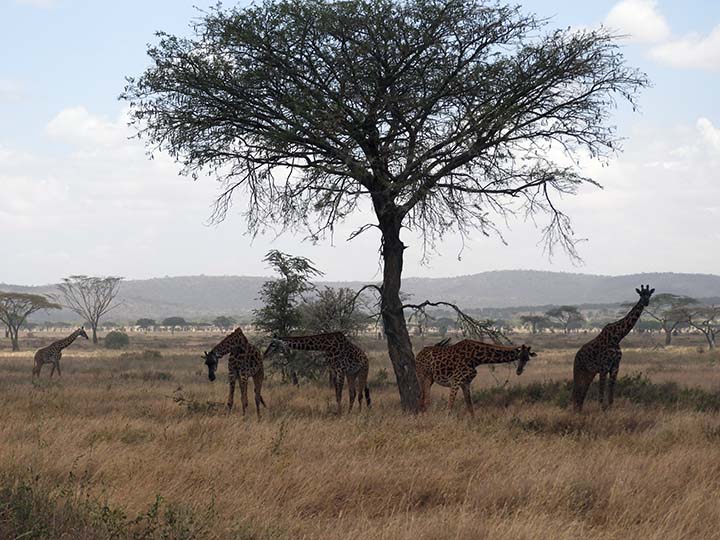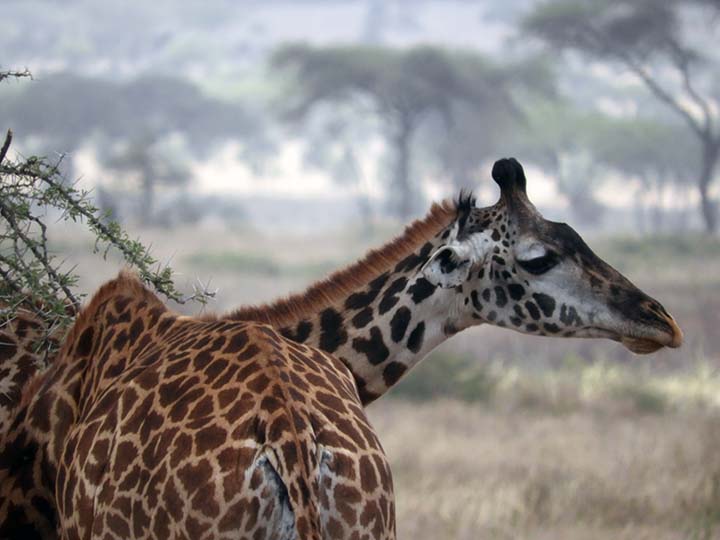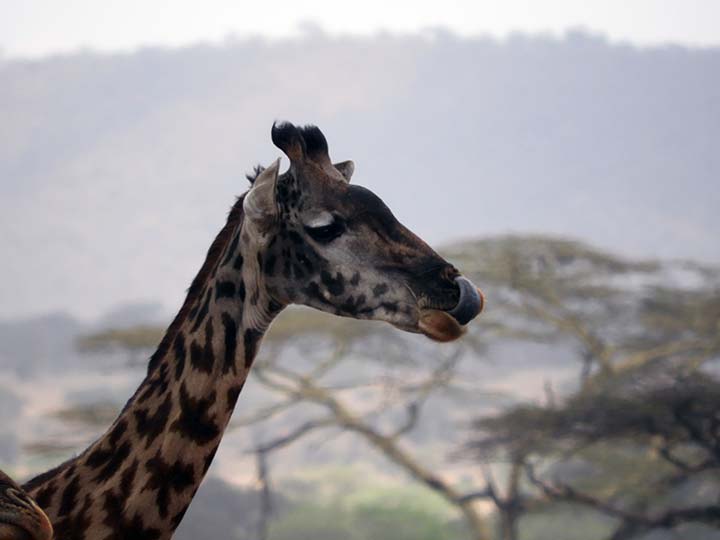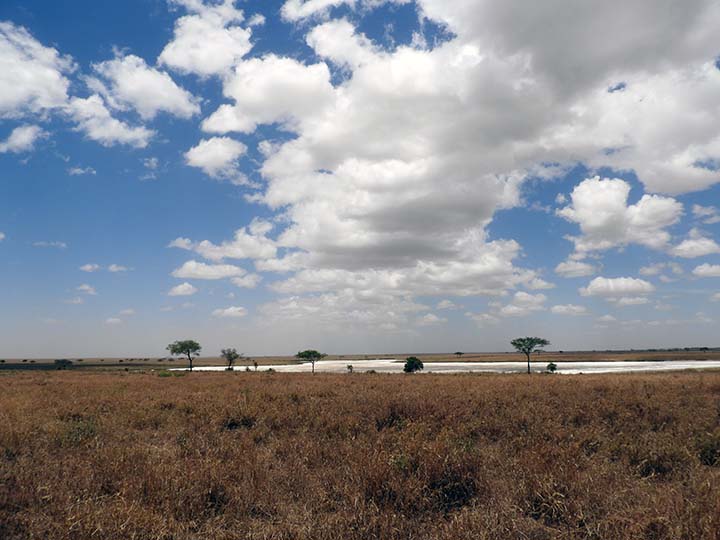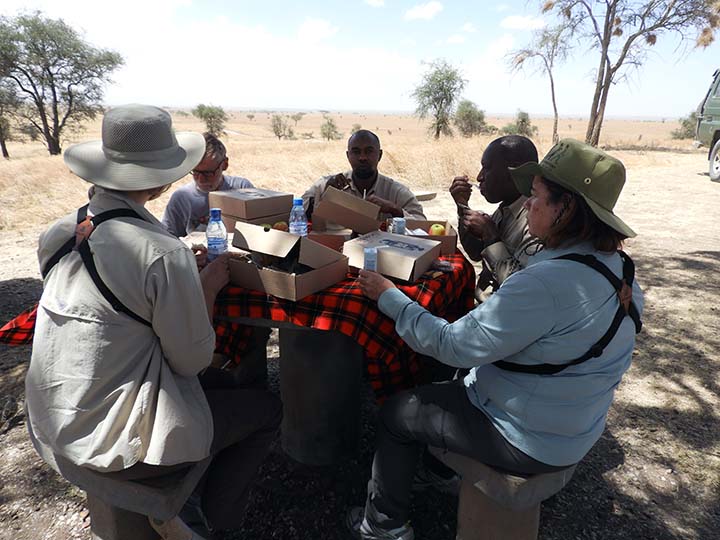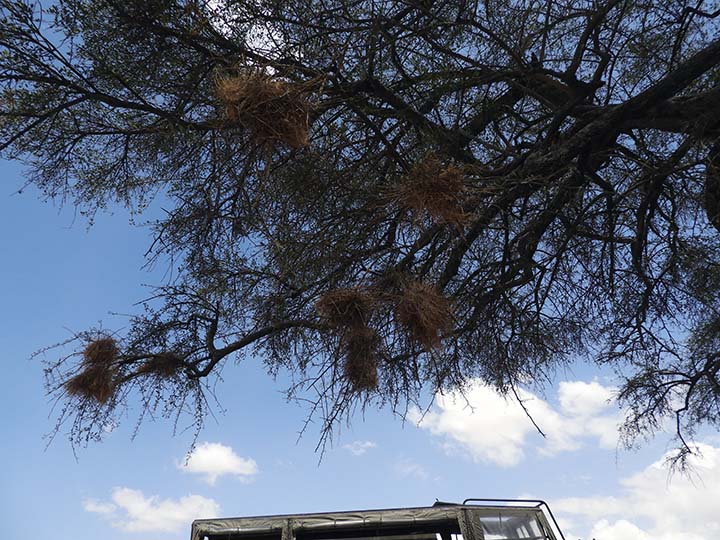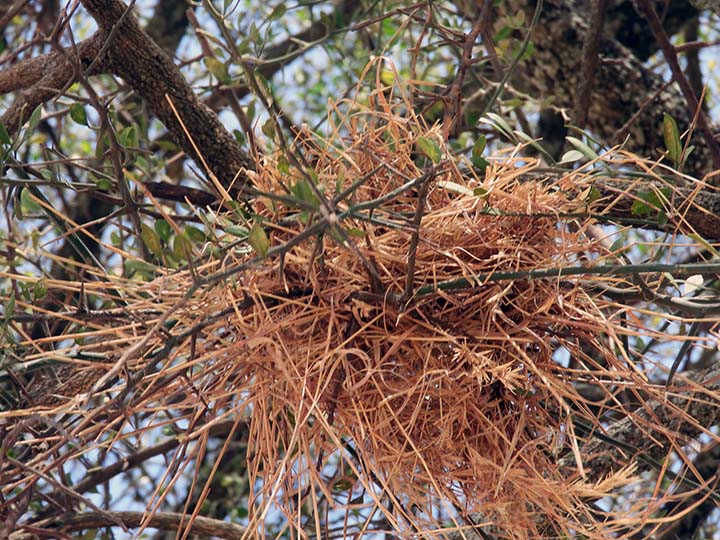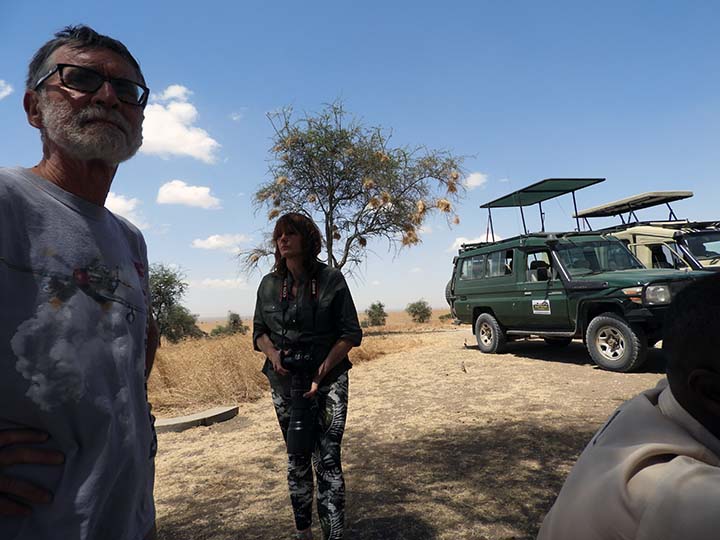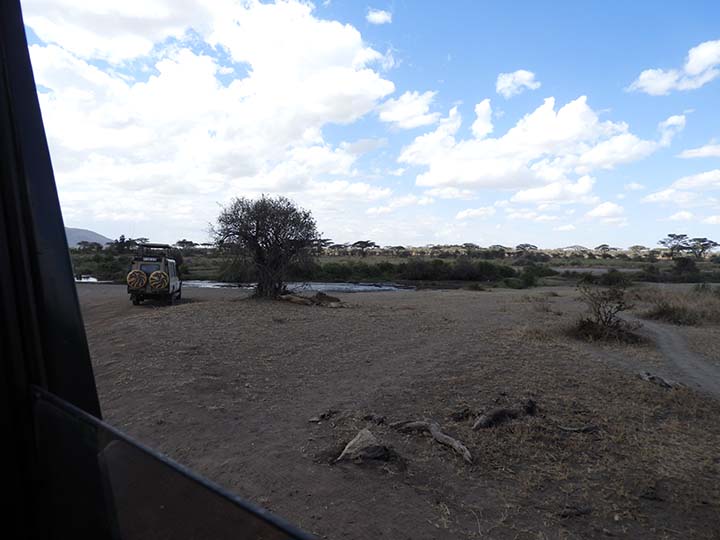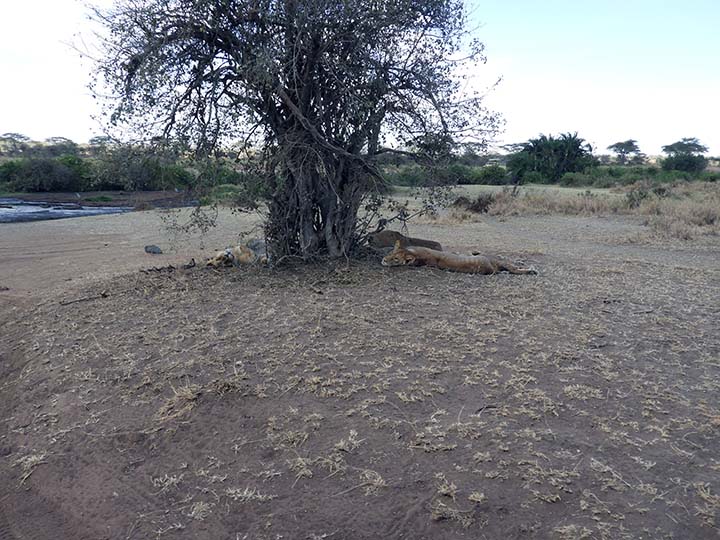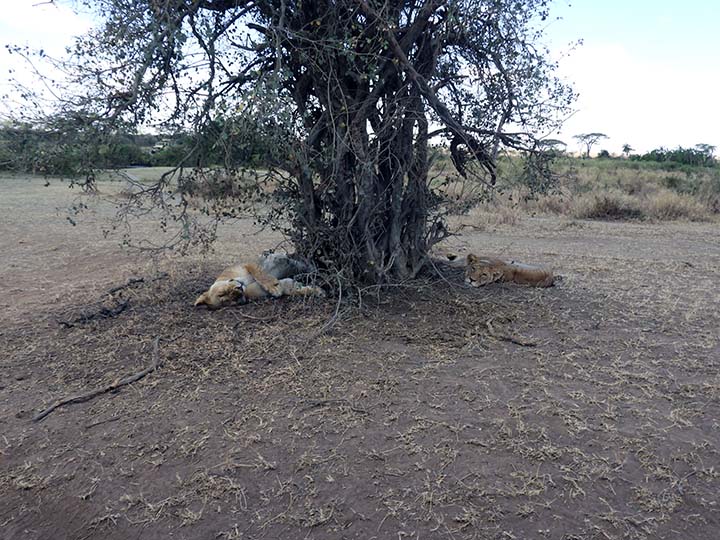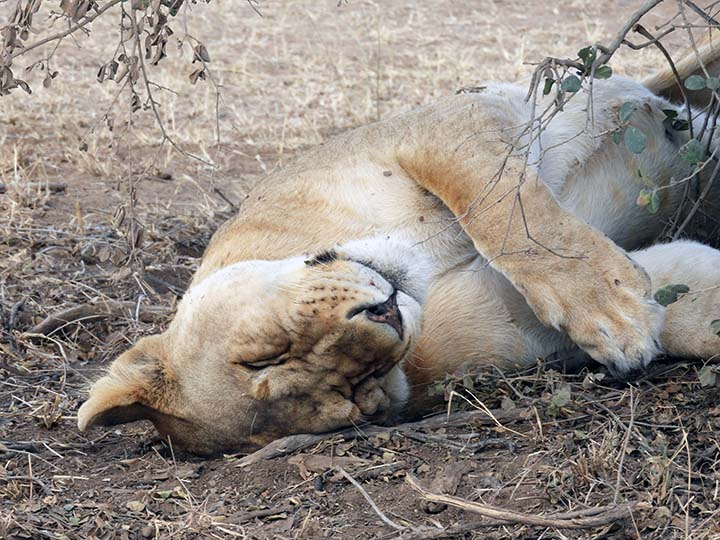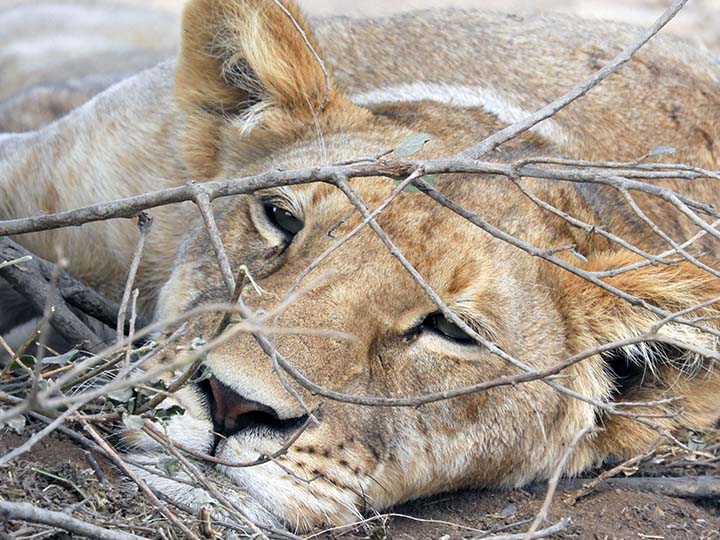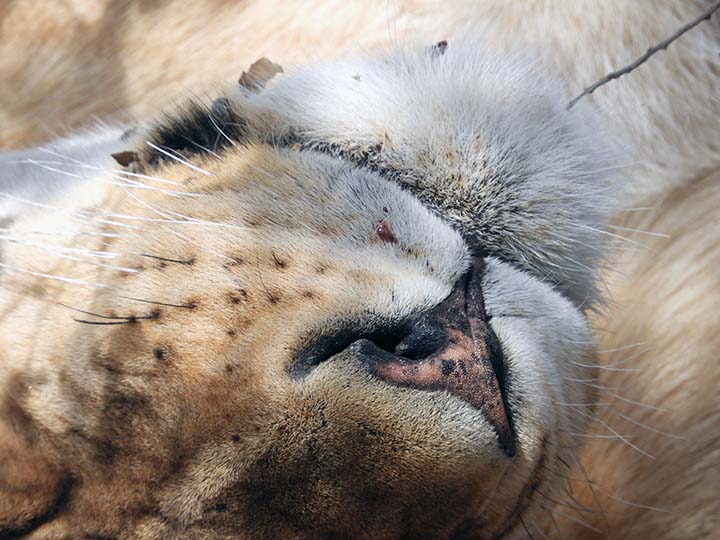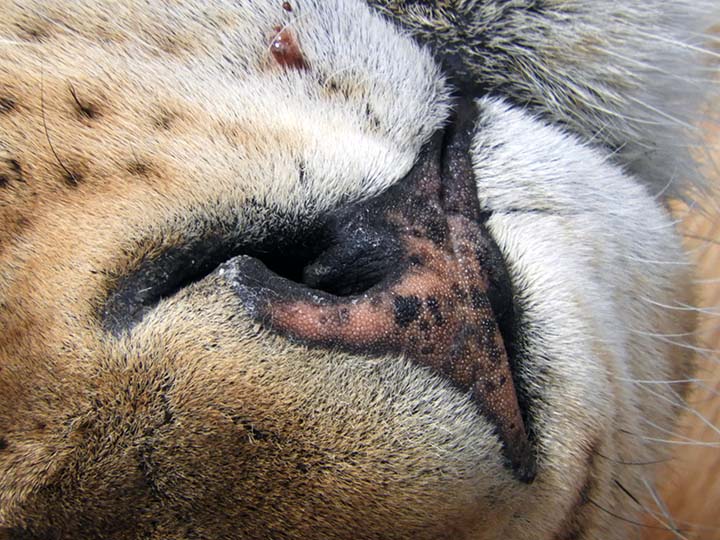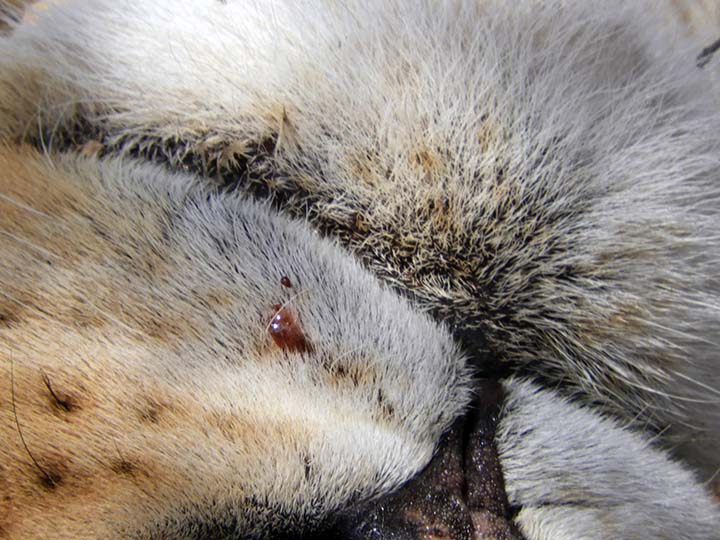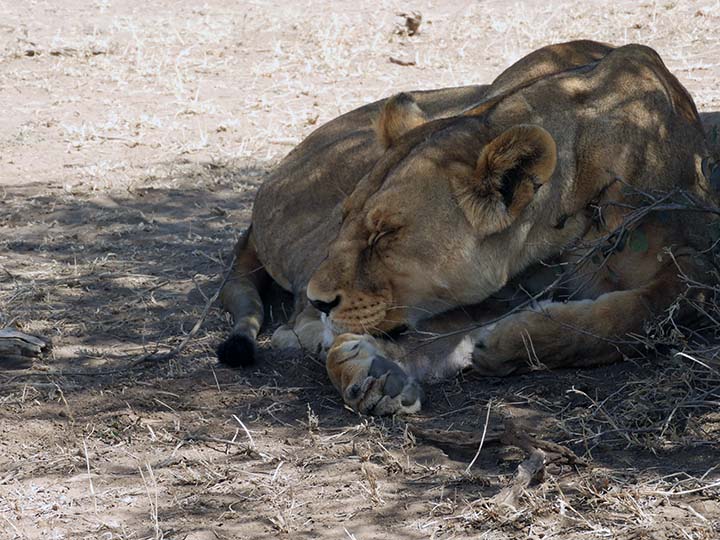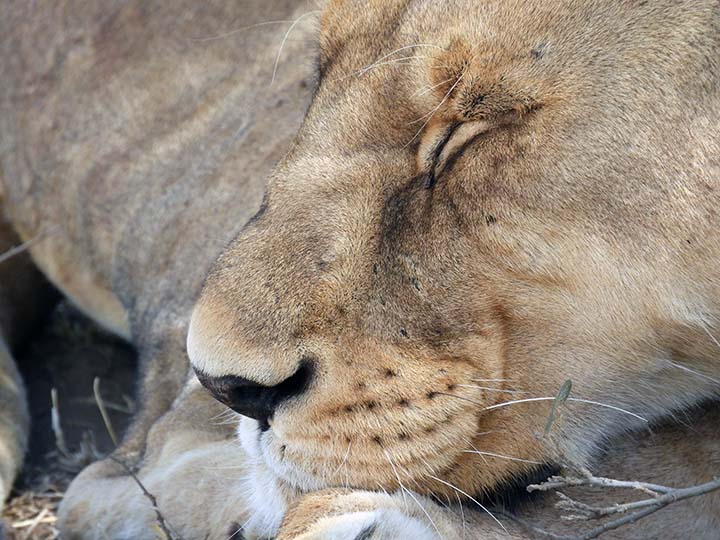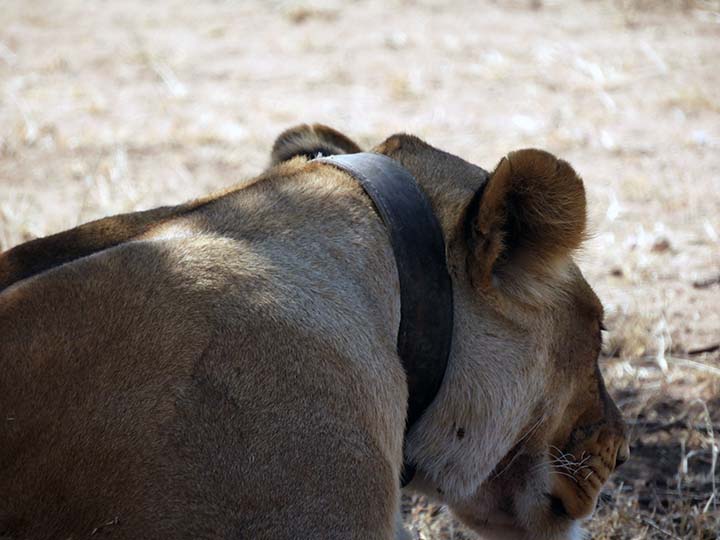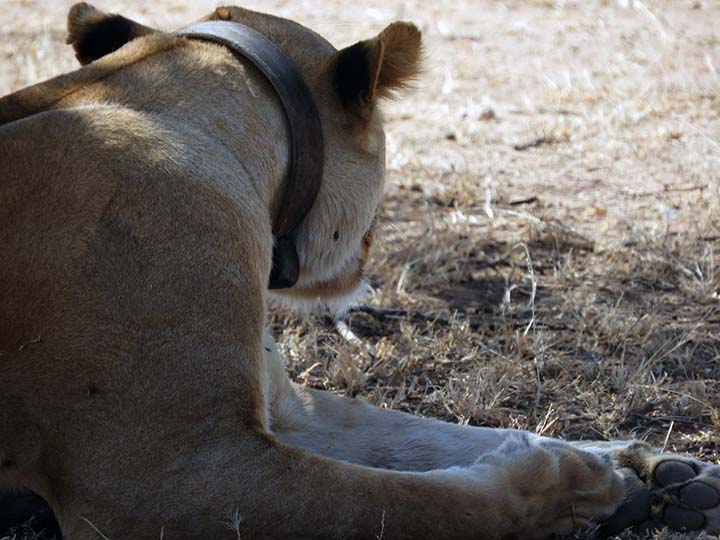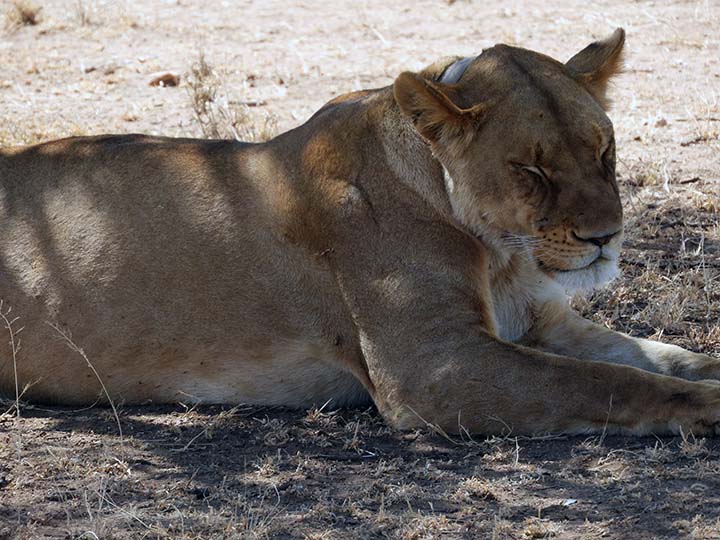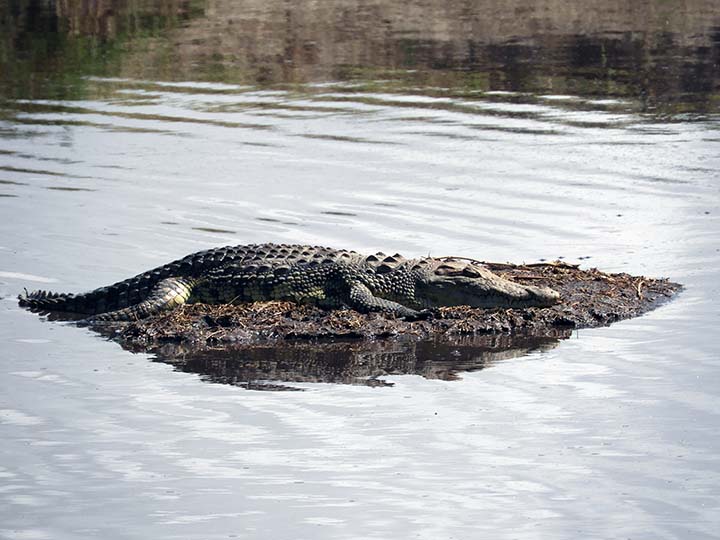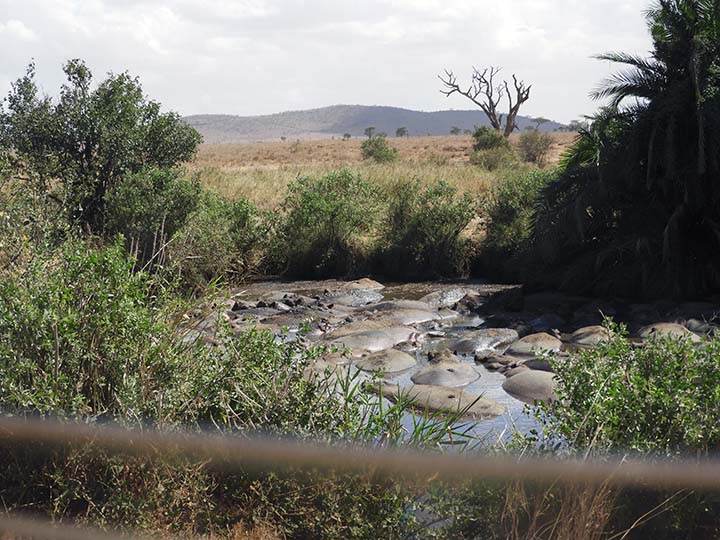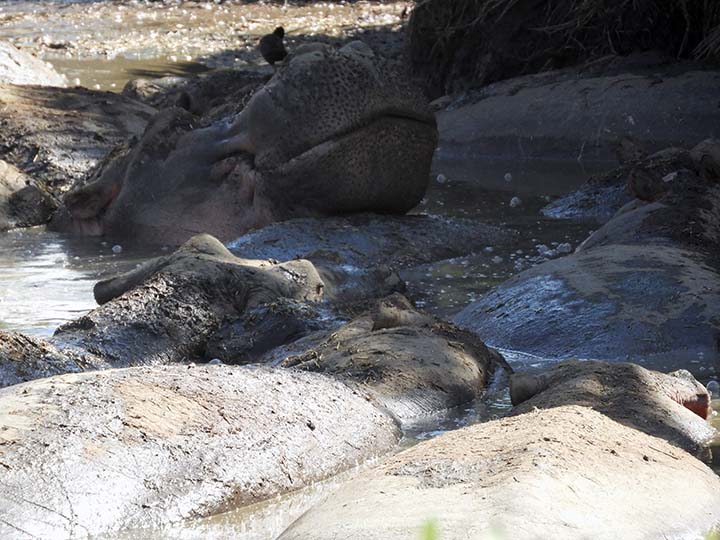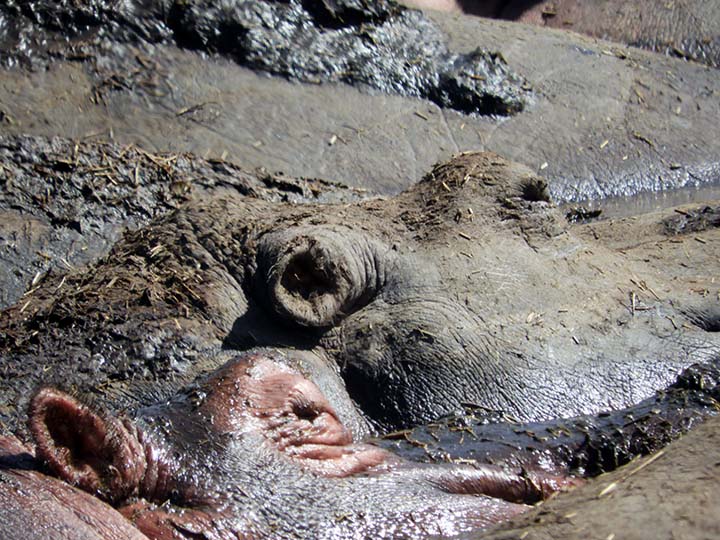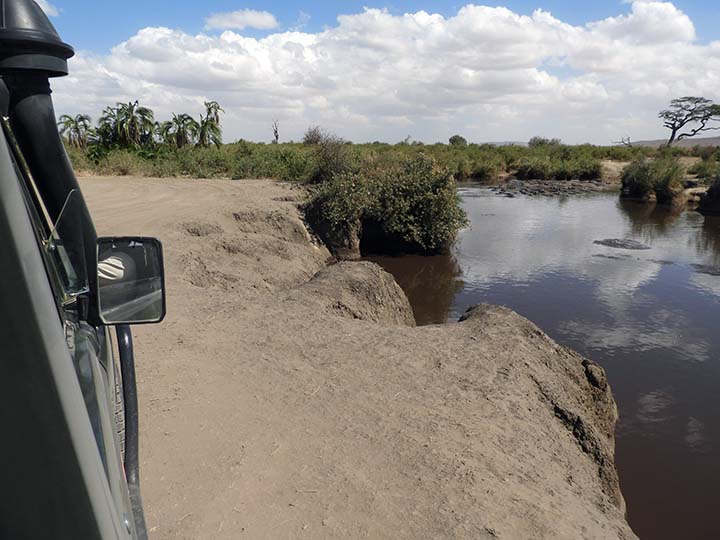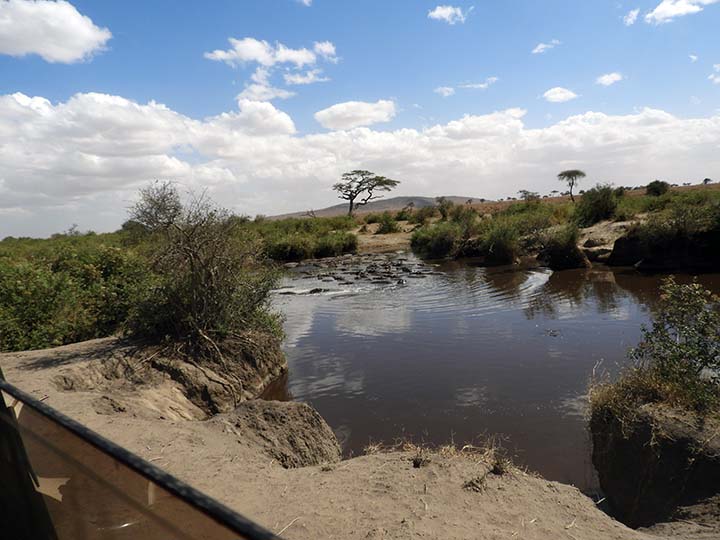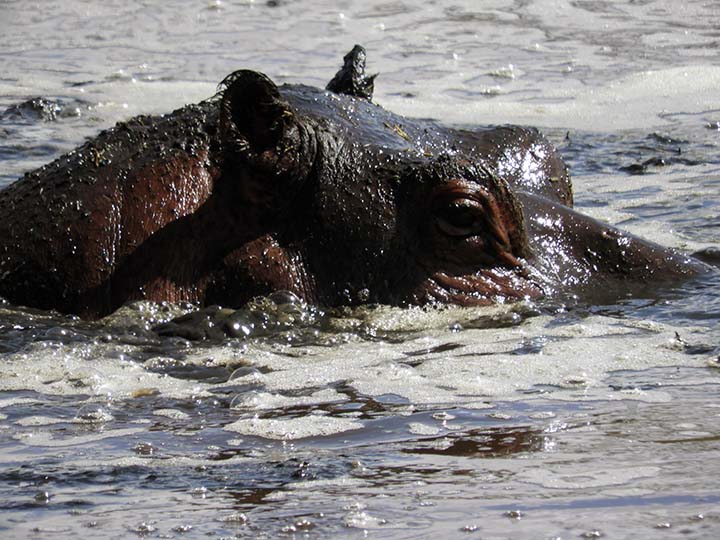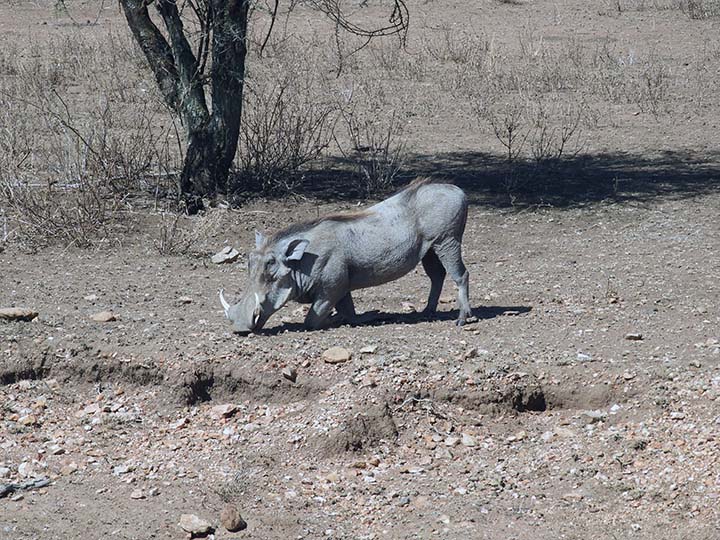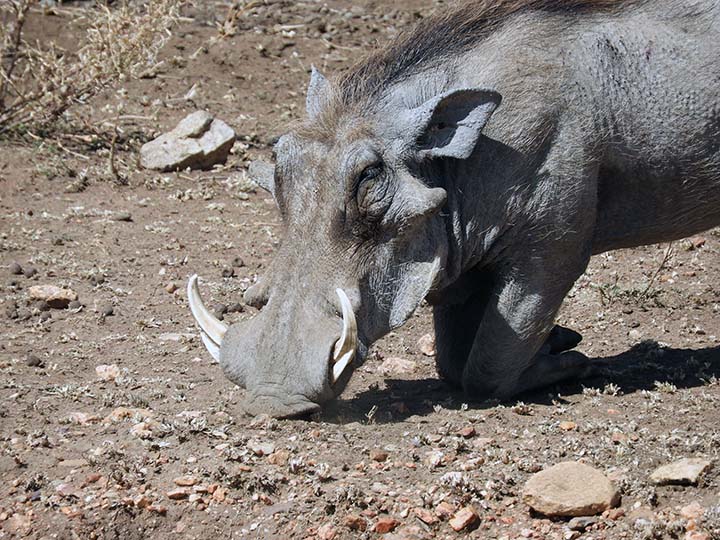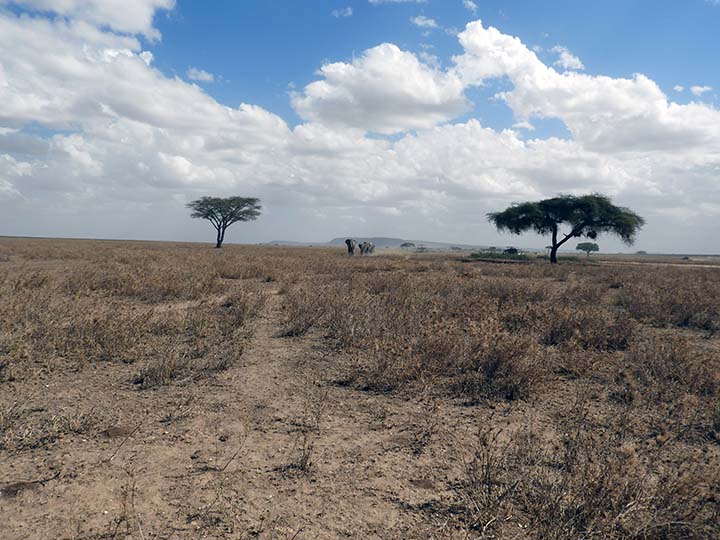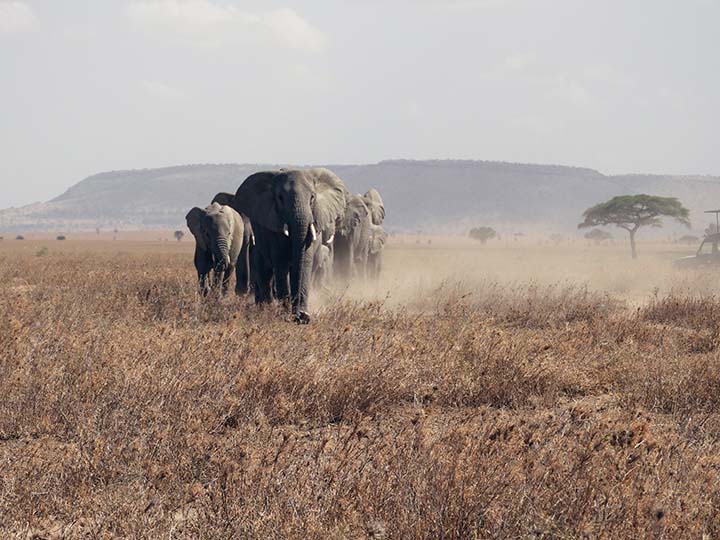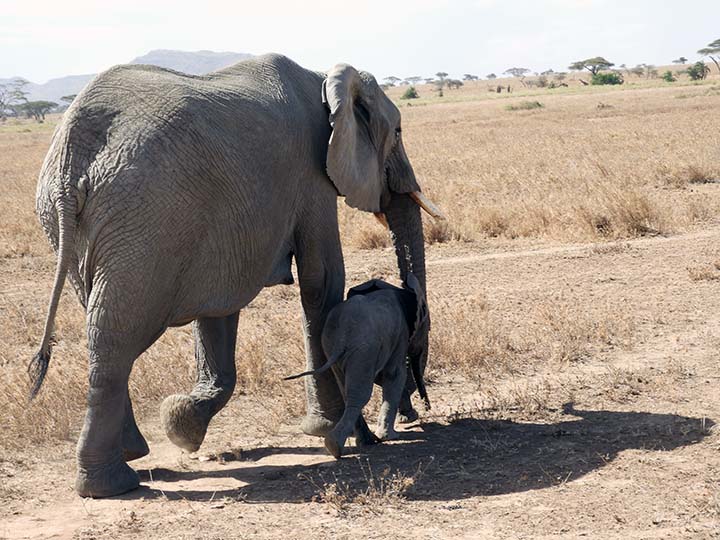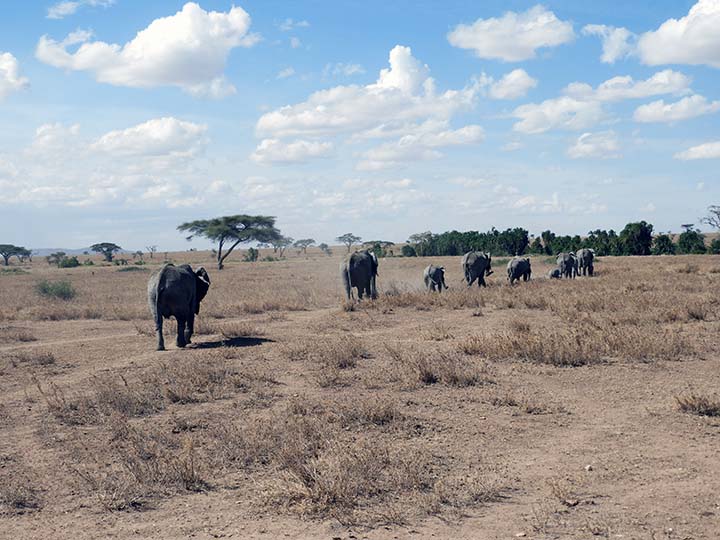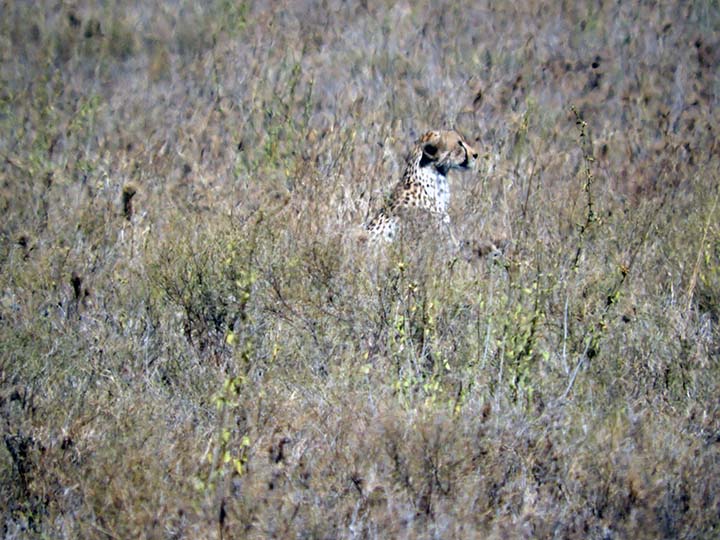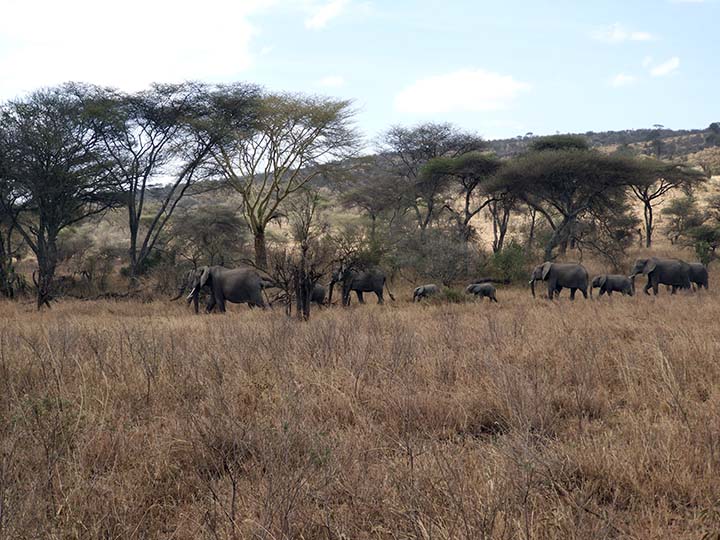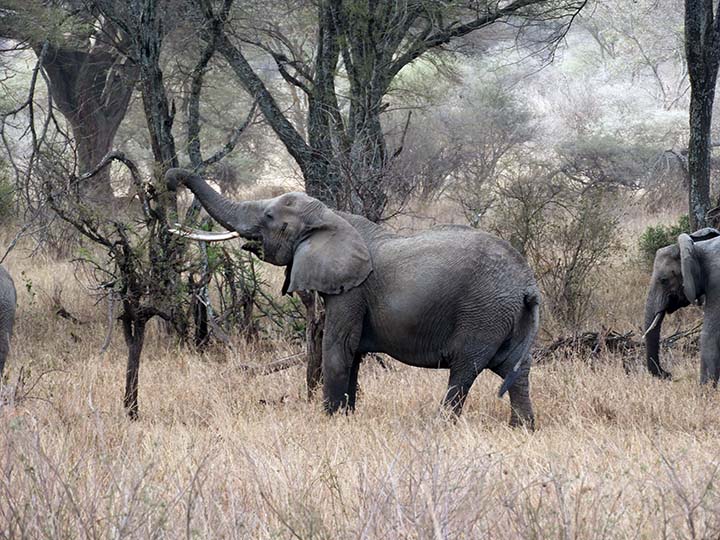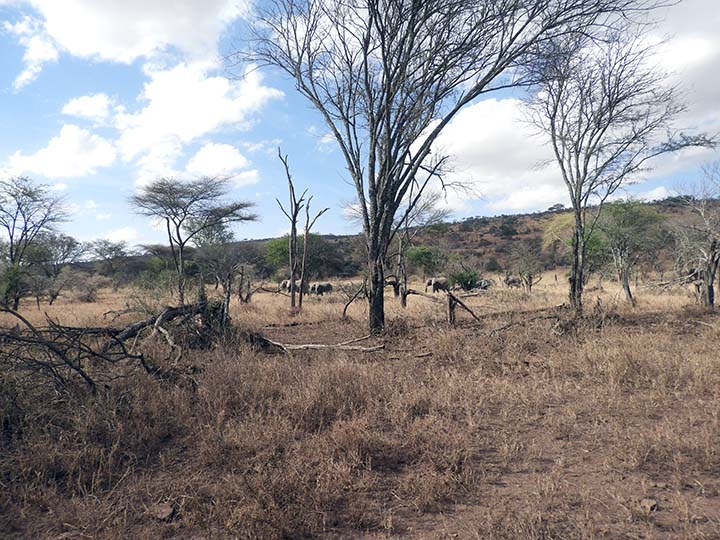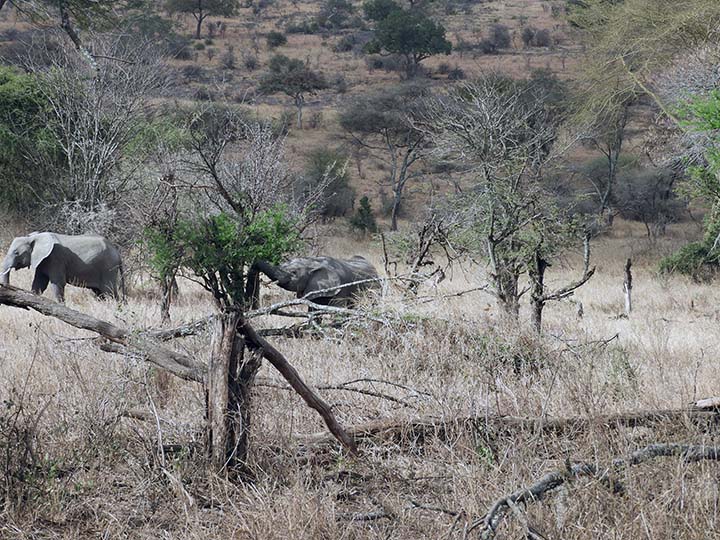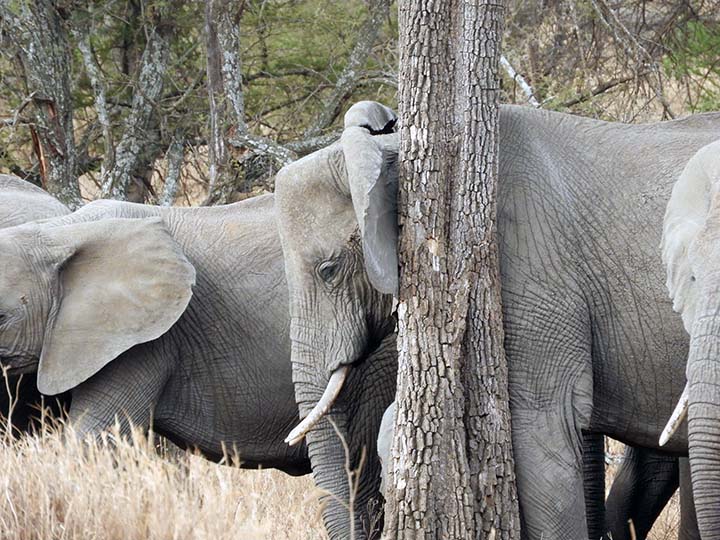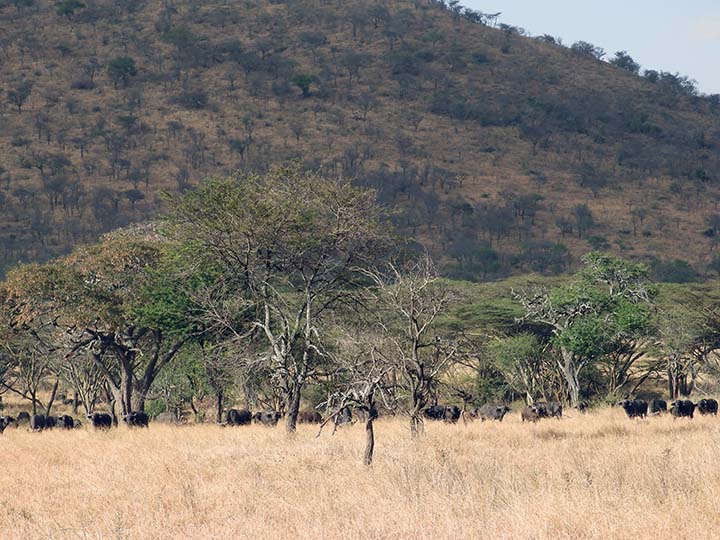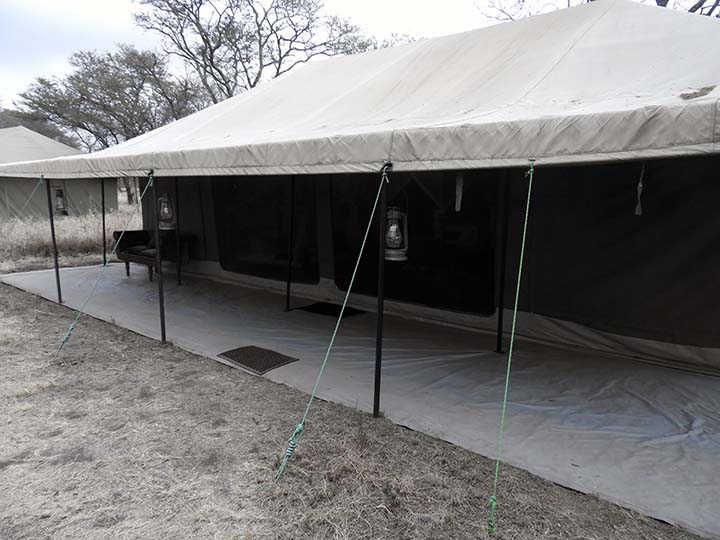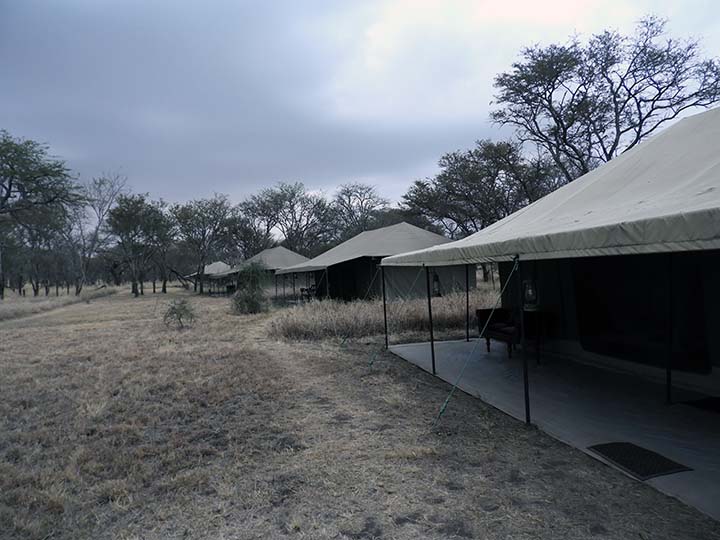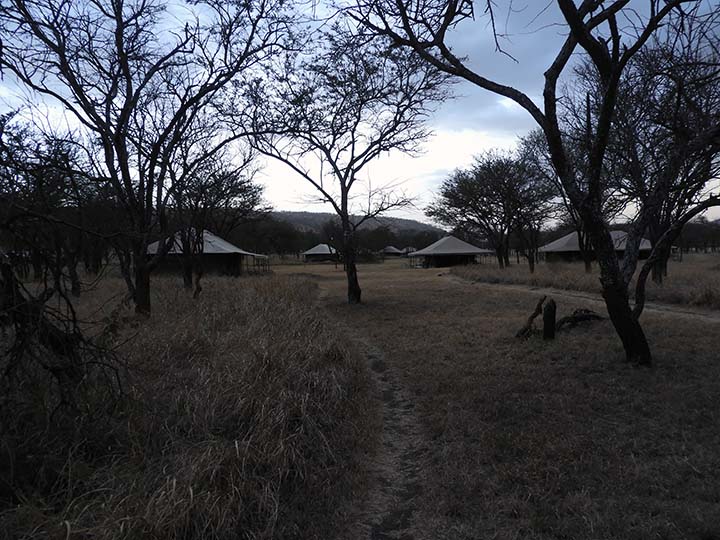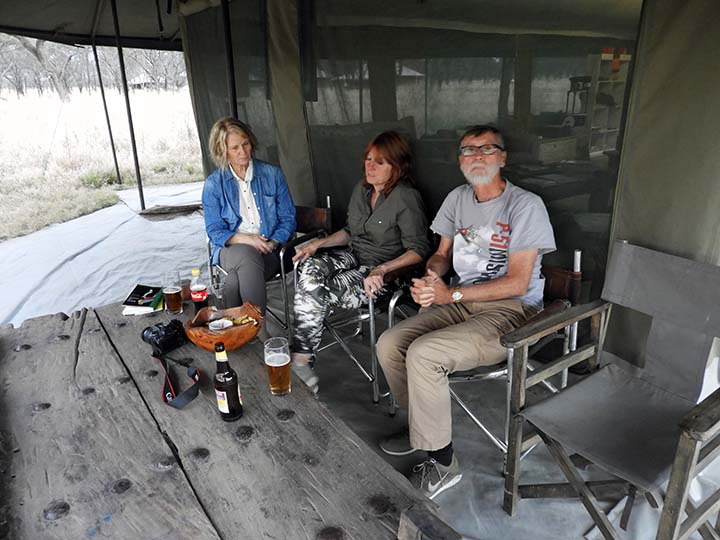|
One thing that's becoming apparent on this trip is that the feeling you get at night when you're drifting off to sleep -- that "tomorrow will surely be a disappointment compared to what we've just experienced" -- simply doesn't hold true. Wait'll you see what we encountered today....
Let's go find some animals.
Looks like others have been this way before.
More evidence of elephants scratching their backs.
I think I see some gazelles over there.
Yep, gazelles.
That, I do believe, is a southern ground hornbill. I'm getting really good at Googling this stuff.
Elephants have been here.
So have gazelles.
Just look at them run.
Thompson's gazelles. I can tell from their butts and that black racing stripe.
Brown over the tail -- that's Thompson's.
Well this time Google has let me down. I can't find any bird with that coloration. Marsha?
What on earth are those things hanging from the tree?
Sausages. Of course. Kigelia, or "sausage tree," or "cucumber tree," or yeah...there's another name too...is a plant of many talents. It's sacred to many African communities; important meetings are held beneath its branches. The tree's fruit is widely used in traditional and Western medicine, including commercially available skin lotions. Maasai girls carry dolls made from the pods. In the Ndebele tribe if a family member dies far from home, a sausage tree fruit will be buried in place of the body. The tree is also believed to contain powerful medicine to ward away evil spirits. The sausage tree’s fruits are used to make a traditional beer enjoyed by the Kikuyu people. In addition to consumption, the beer is also commonly used as a soothing bath for children suffering from measles. This stuff can be used to create topical treatments for everything from skin afflictions to intestinal worms. There are some steroid chemicals found in the sausage tree that are currently added to commercially available shampoos and facial creams. This fruit can treat malaria, headaches, syphilis and other venereal diseases, rheumatism, inflamed spleen, ulcers, and gastrointestinal issues. The fruit is known to have anti-microbial properties, and is thought to help with skin problems like eczema and psoriasis. It often even makes its way into high-end anti-aging and beauty products! We should all have one in our backyards.
I think I see an elephant.
Yep, a big one.
And a giraffe.
The grass may be blackened by wildfire, but he doesn't care. He can reach all the way up to the good stuff at the top of the tree.
Well, hello there.
Coming over to check out the Land Cruiser, are we?
Taking a good look.
Getting a little close.
Maybe a bit too close? And what's all the huffing and puffing about?
Don't walk off in a huff. And a puff.
Uh, oh, he's coming back.
And he seems to want to challenge us.
This is getting interesting.
I mean, in a fight between an African bull elephant and a Toyota Land Cruiser, who would win?
Do we want to find out?
Oh my goodness...
YOU SHALL NOT PASS!!
Let's go to the booth for an instant replay...This was so much fun we don't want to miss a single second.
Thanks to Myras for this great video of the elephant trying to intimidate the Land Cruiser. I had my camera set for stills at this point and I missed capturing the full drama.
But when push comes to shove, it turns out a pushy elephant can be chased off by the sound of a revving Toyota engine. Look at him go!
Bye, Mr. Elephant.
You just imprinted yourself as a memory of a lifetime for three fascinated tourists.
There's that pretty starling again. He really gets around.
I see another kopje.
Wonder if we'll find a hyrax?
I see you up there.
And I think you see me.
Cute little rock rat.
Don't get too close to the edge.
It's a long fall from way up there.
I guess they're just enjoying the view.
Do you bite? You look like you'd bite.
More gazelles.
Do you know what kind by now?
White over the tail and no racing stripe. Grant's gazelle.
Yes, buddy, I know you're a Grant's gazelle.
Is this what's meant by "the pickings are slim?"
I dunno what it is for sure.
But I've been Googling and the best I can come up with is that it looks like a reedbuck.
They look like female reedbucks. So I declare them to be reedbucks. Until somebody corrects me.
Another sausage tree?
Yep, another sausage tree.
Always wanted to see video of a sausage tree? OK, here's your chance.
We have vast plains like this in the USA, but you don't often see giraffes like this off in the distance.
See? Giraffe.
More giraffes, and they're moving.
When you see a giraffe, you gotta take a picture, don't you?
Hey...what's that walking over there in the dry grass?
It's a leopard. And how do I know it's not a cheetah? Cheetahs have spots where leopards have rosettes. The spot of a cheetah is a clear, single, black spot separated from the other spots on the cat's body. A leopard however, has smaller irregular shaped spots that group together in circles to form rosettes.
So that's a leopard.
He's on the prowl.
Maybe a Thompson's gazelle for lunch?
Looks awfully tasty.
But gazelles can run fast, and this one has his eye on you.
Not even blinking.
Ah...I wasn't hungry anyway.
I believe I'll just rest in the shade for a bit.
There must be other snacks around here somewhere.
Maybe if I just lie low here in the grass something will amble by.
I hope.
This is too much work.
Leopard in motion.
Say...those tourists could be tasty.
Nah...too much trouble.
But I've got my eye on you.
I know you're up there snapping pictures like crazy.
I've been through this with you tourists before.
Don't even THINK about coming over here.
Yes, I'm talking to you.
I'm in charge out here.
Maybe I should hide...
Nah, I think I'll jump up here and have a look around.
Just a little quick jump.
Right up here.
Get a good claw hold.
Do a little scrambling.
Alley...oop...
Ah...I can see better now.
Secretary bird. I'm getting better at this now...named him without even looking him up.
The rocky outcroppings around here are called the Moru Kopjes. We've stopped at a ranger station to learn about efforts to preserve the black rhino population.
The biggest danger to the rhinoceros population is poaching.
The ranger is showing us how poachers set snares.
Rhinos have very sharp teeth.
Hey...there's one now.
And just close by there's an elephant.
The two seem to be having some sort of disagreement.
Let's watch the rhino and the elephant stare each other down.
He's a black rhino. I know, he looks white, or gray anyway, but he's a black rhino. Actually all rhinos are about this color. So what's the difference between black and white rhinos? I'm glad you asked. The difference has nothing to do with color. It turns out that back in the day when the Dutch were naming things around here they realized that two rhinoceros species are found in sub-Saharan Africa and they look similar to one another. The major difference is the shape of their mouths. Black rhinos developed a pointed lip which they use to pick fruit from branches and select leaves from twigs; white rhinos have a flat, wide lip to graze on grasses. So the Dutch called the wide-lipped rhinos "wijd," which to English speakers sounded like "white," and naturally if these are white rhinos, the others must be black rhinos. Right? Well, that's the commonly accepted explanation anyway.
He's a big guy.
And you really don't want to get in his way.
Not even if you're an elephant.
So just let me pose for you this way....
And that way....
And maybe one more pose from my best angle...
I think I've attracted enough tourist attention now.
I'll just take the birds on my back and be on my way.
Giraffes!
I keep telling you: never pass up an opportunity to take pictures of giraffes.
I see you back there.
That tree was yummy.
The tourists are getting hungry too. Let's see if we can find a place to have a nice snack.
That looks nice. It's like a hamburger with tomato, cucumber and butter. It was about as good as it sounds.
But we really were hungry.
And we'd found a nice place to stop.
So we chowed down.
Weaver bird nests.
They're kinda messy housekeepers.
But you just don't see this kind of thing back home, do you Myras?
Just look at that. Buncha busy weaver birds around here.
Who's that resting in the shade by the riverbank?
Lions!
Lazy lions.
Just oversized house cats.
Want me to come over and scratch behind those ears?
Tickle under your chin?
Say...what's that droplet on your chin?
Blood? Uh oh...
Maybe I'll stay back.
You think that's a good idea?
Yep. Good idea.
Hey look...she's wearing a collar!
Very stylish.
The transmitter attached to the collar helps conservationists track and protect the lions.
Crocodile!
Do you know what you call a group of hippos? Herd, pool, raft or bloat -- they all work.
This looks like a bloat of hippos to me.
Want to see them move? I did too, but there wasn't a lot going on.
They just lie there. Bloated.
But sometimes they come out of the water. See where they've been sliding down the bank to go for a swim? Looks like fun.
There are plenty of them over there.
And they seem content.
Warthog. Poor things have to kneel to get their mouths low enough to eat.
But it works for them.
They may be ugly but they aren't going hungry.
Here come the elephants.
Wherever they're going, they're intent on getting there.
Aww....
I'm sure they have some destination in mind.
A cheetah takes it all in. How do I know he's a cheetah? Spots, not rosettes.
See how they mangle trees?
You'd think they'd have more respect for the forest.
But no...they just want to eat the leaves and scratch their backs.
And leave a mess behind.
For shame, elephants!
Scratch scratch
C'mon, Jr.
Is that bridge safe? Guess we'll find out.
Ostrich!
Impala butt!
Cape buffalo!
Back in the day, when safaris involved actually killing animals, there were five species that were particularly difficult to track and shoot on foot. They have become known as the "big five," and they are: the lion, leopard, rhinoceros, elephant, and Cape buffalo. And guess what? If you scroll back through all the pictures above you'll discover we've accomplished something today not many tourists can brag about: we've seen all the big five in a single day! Yay us!
Time to rest after spending the day tracking the big five.
Soon we'll be zipped up safely in our luxurious tents.
Sharing the land with the wildest of animals.
But we can be pretty wild too. When we're not pooped.
|

